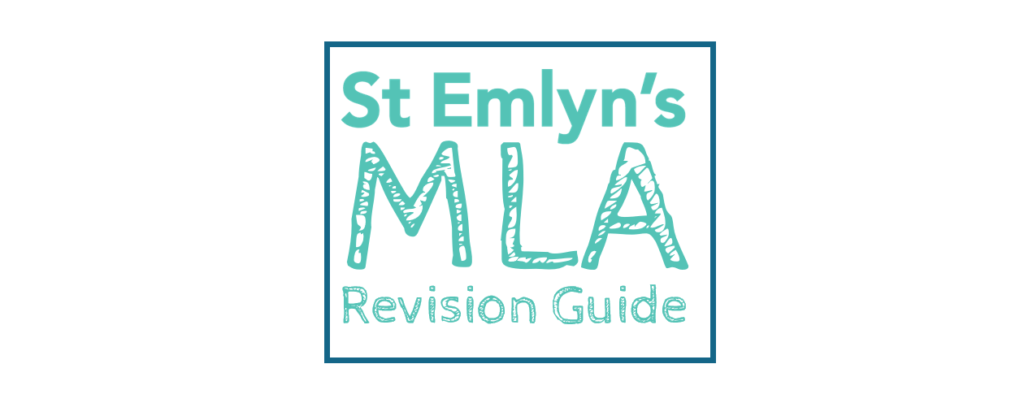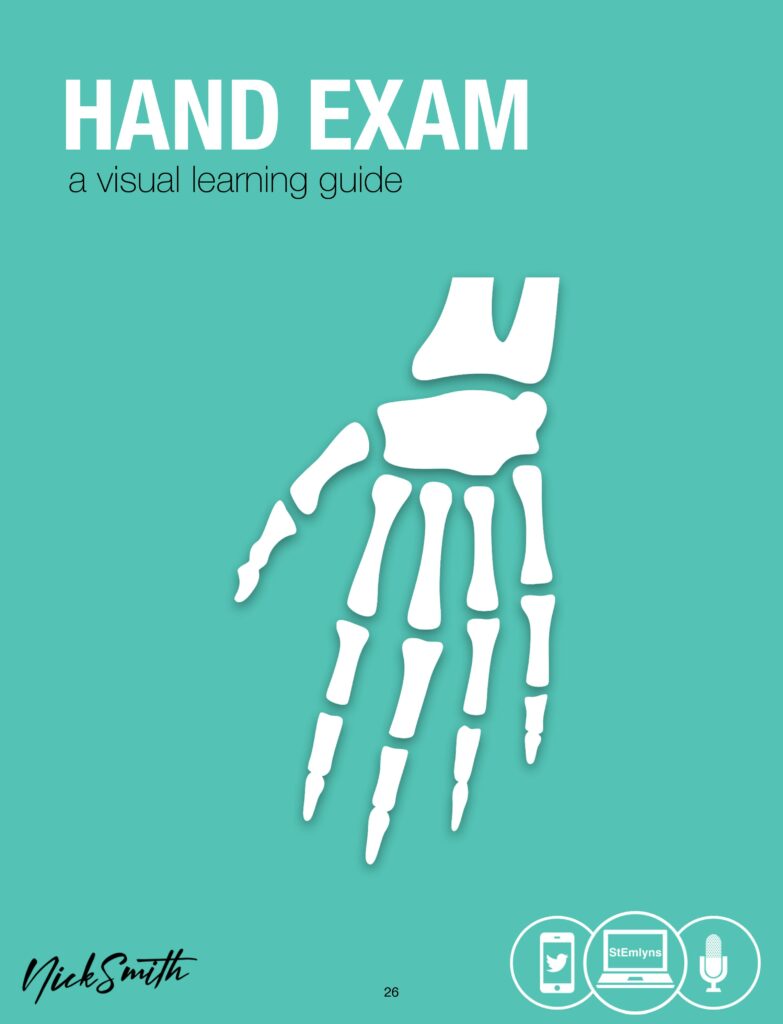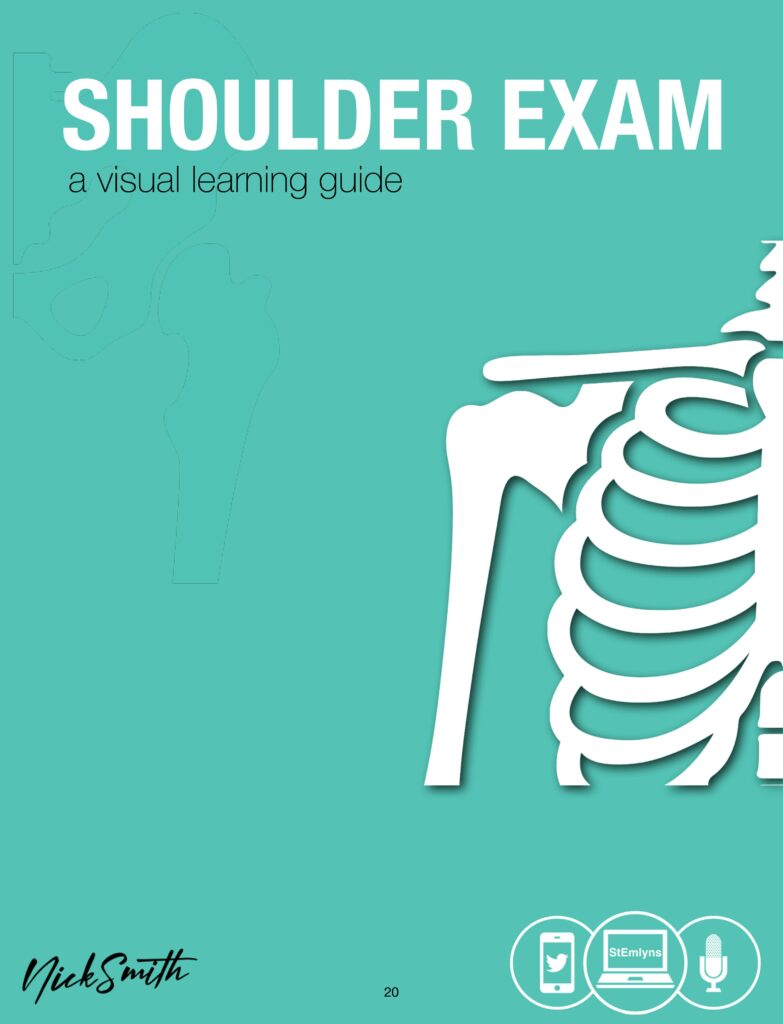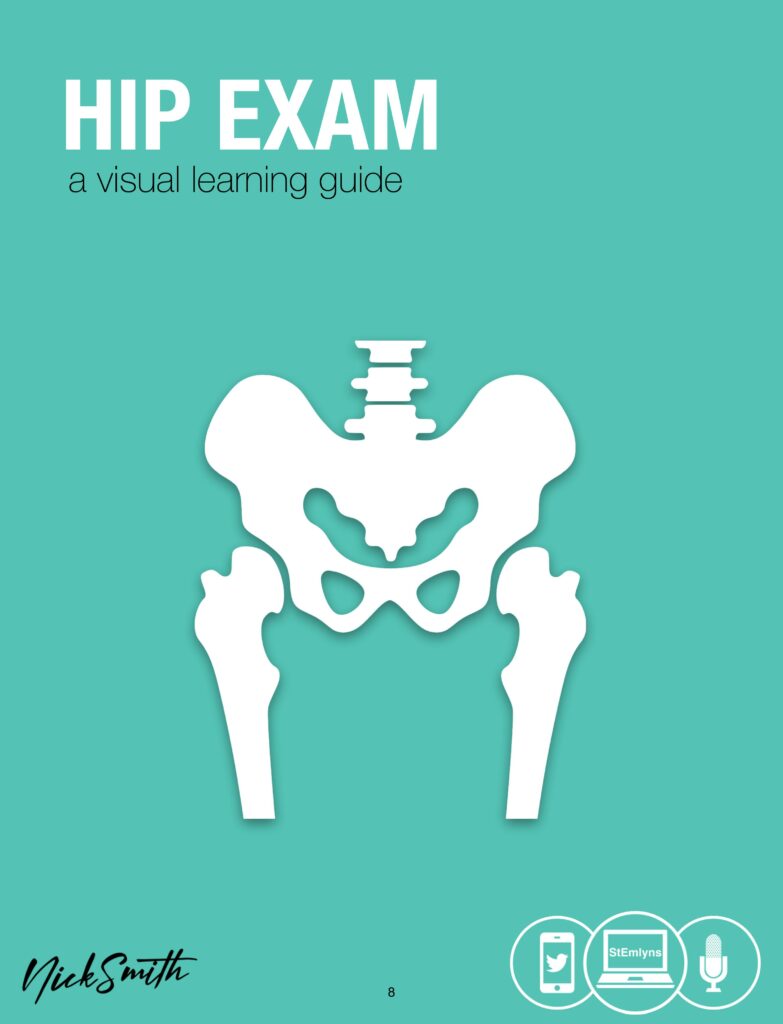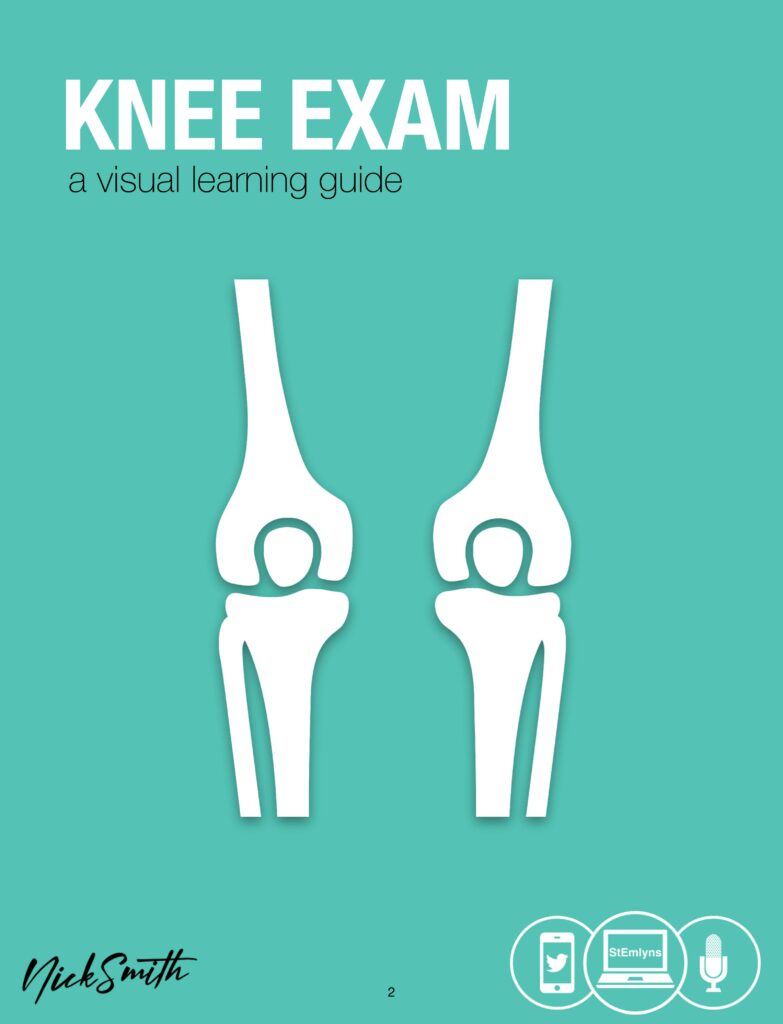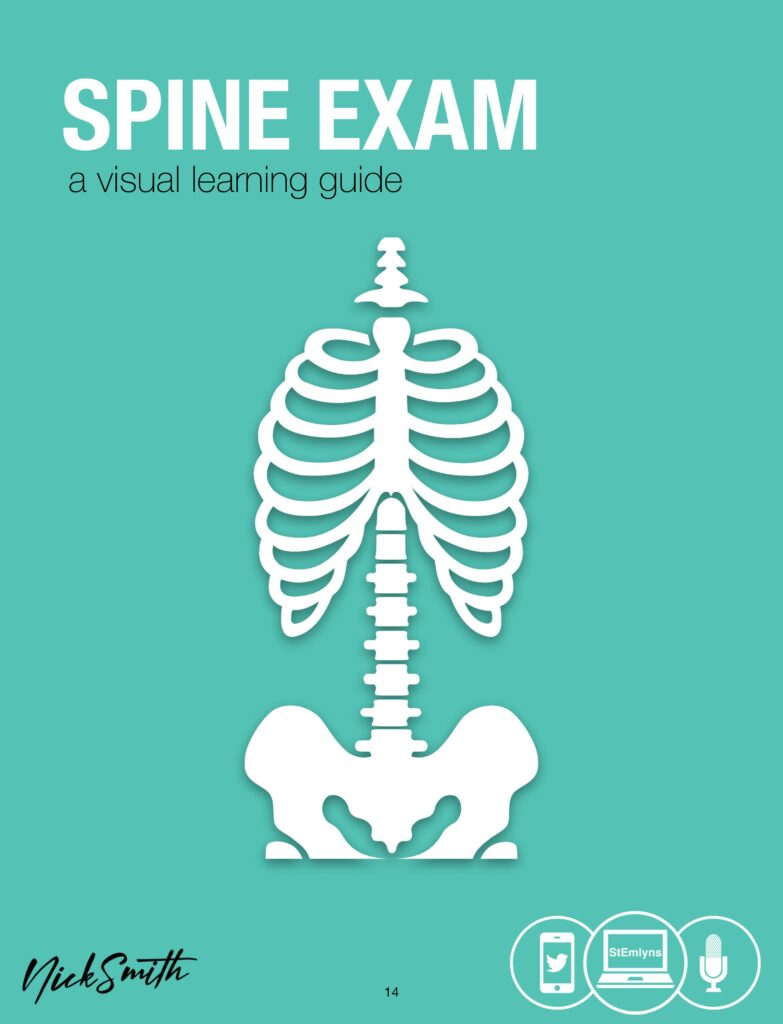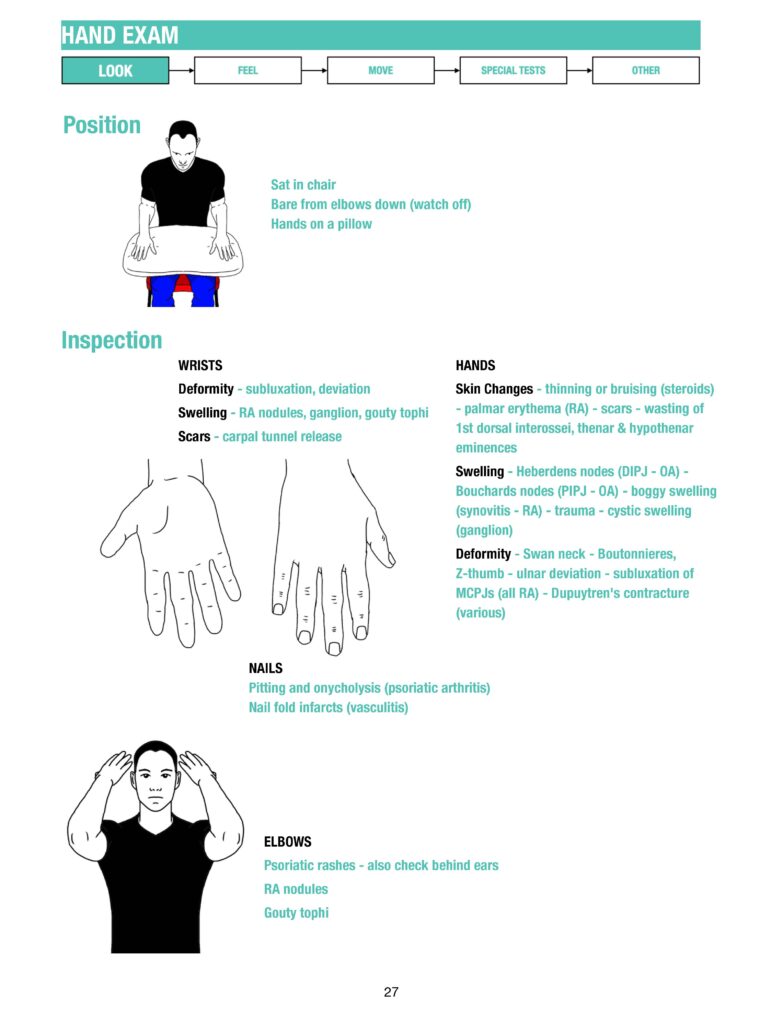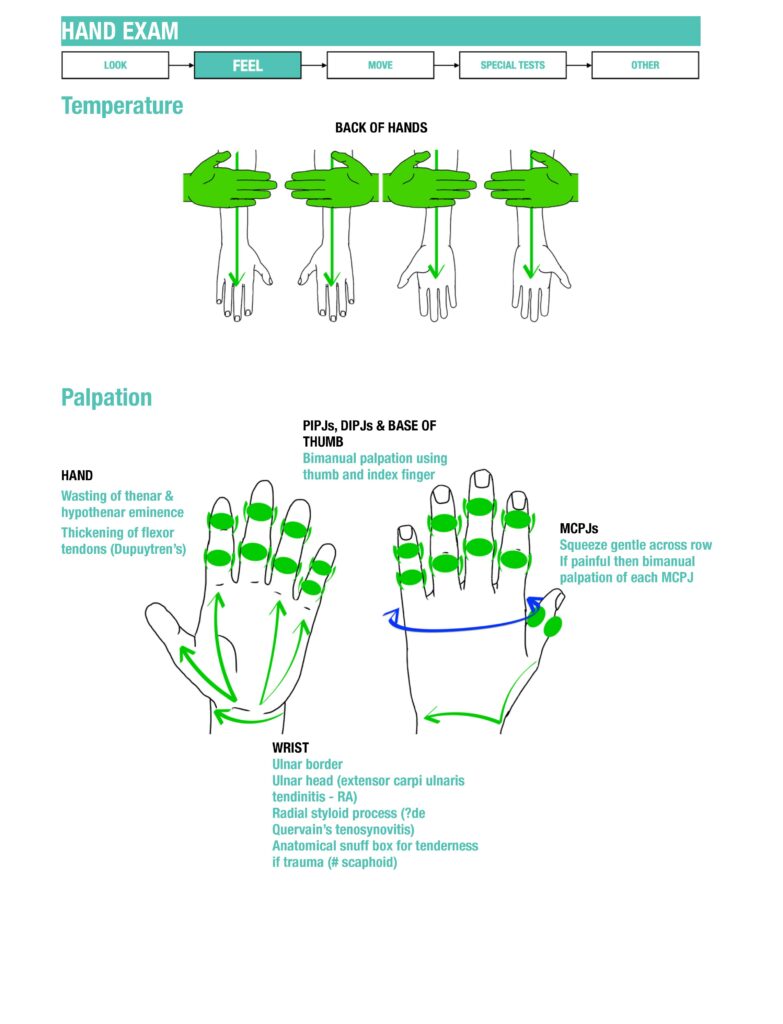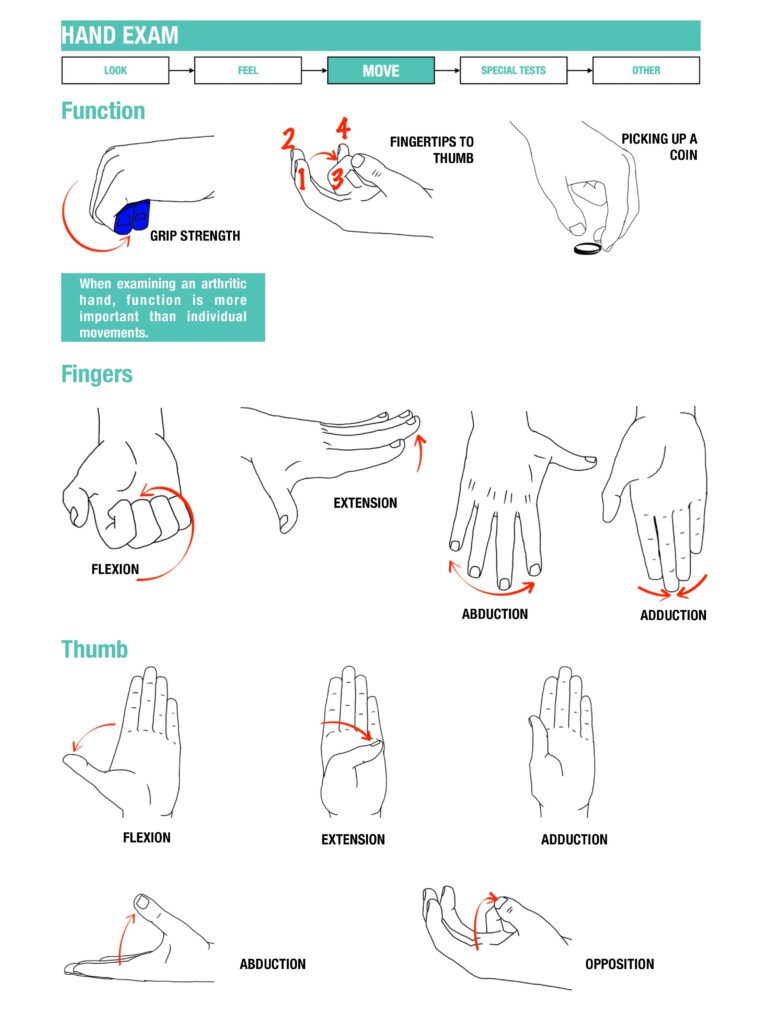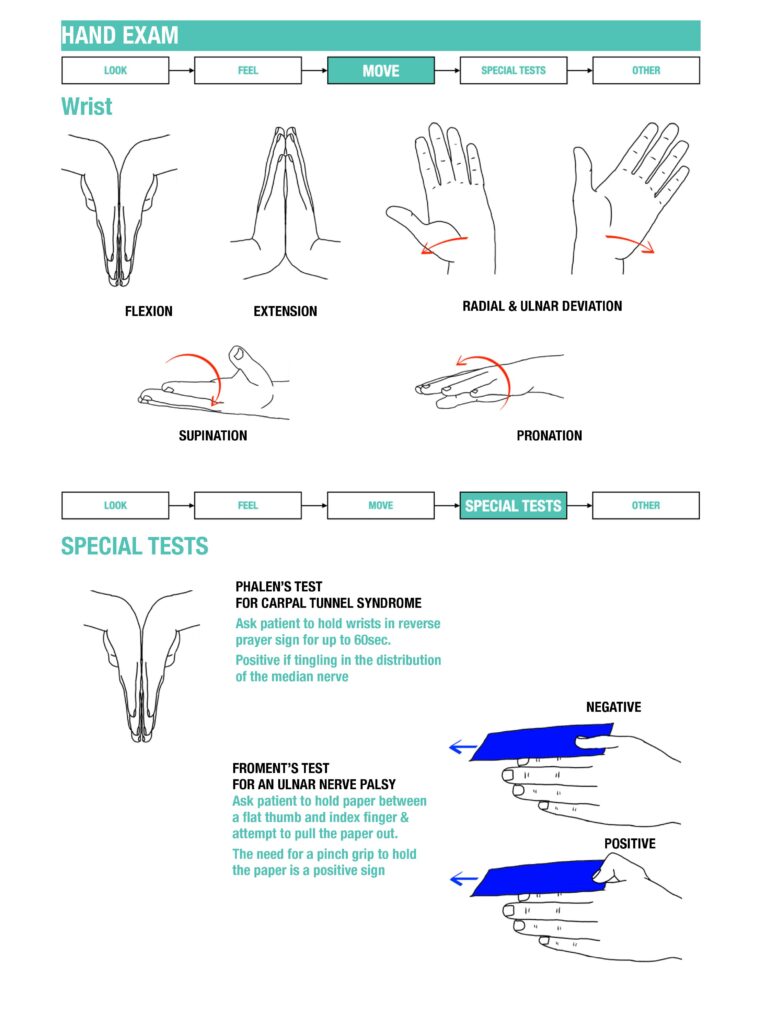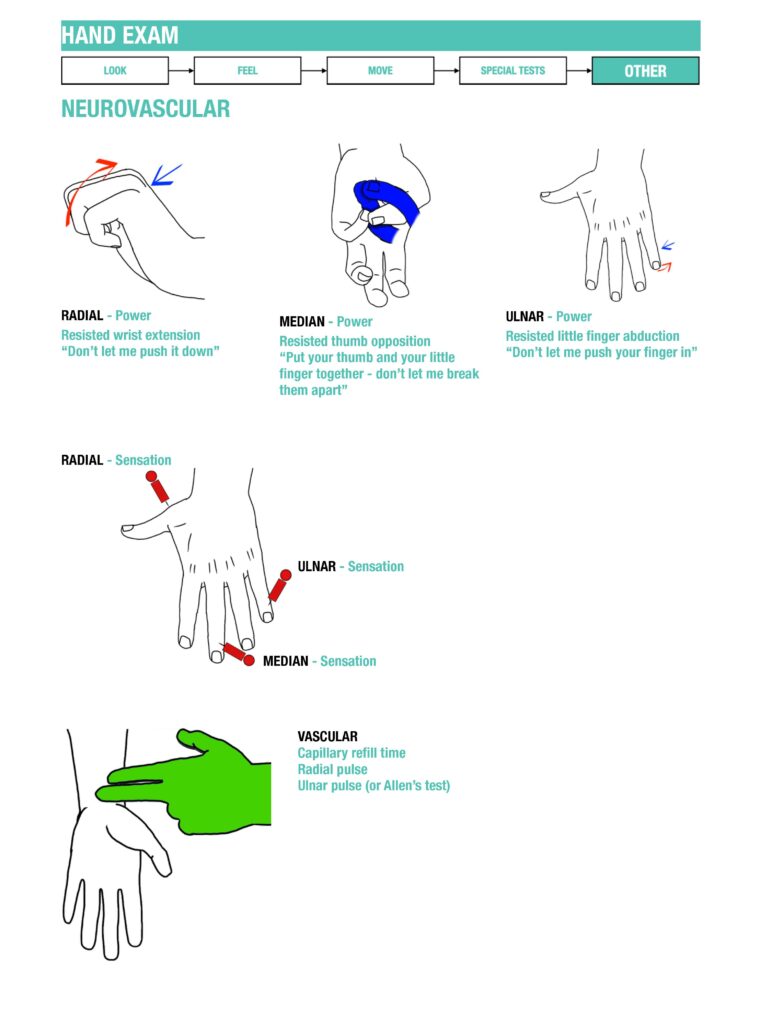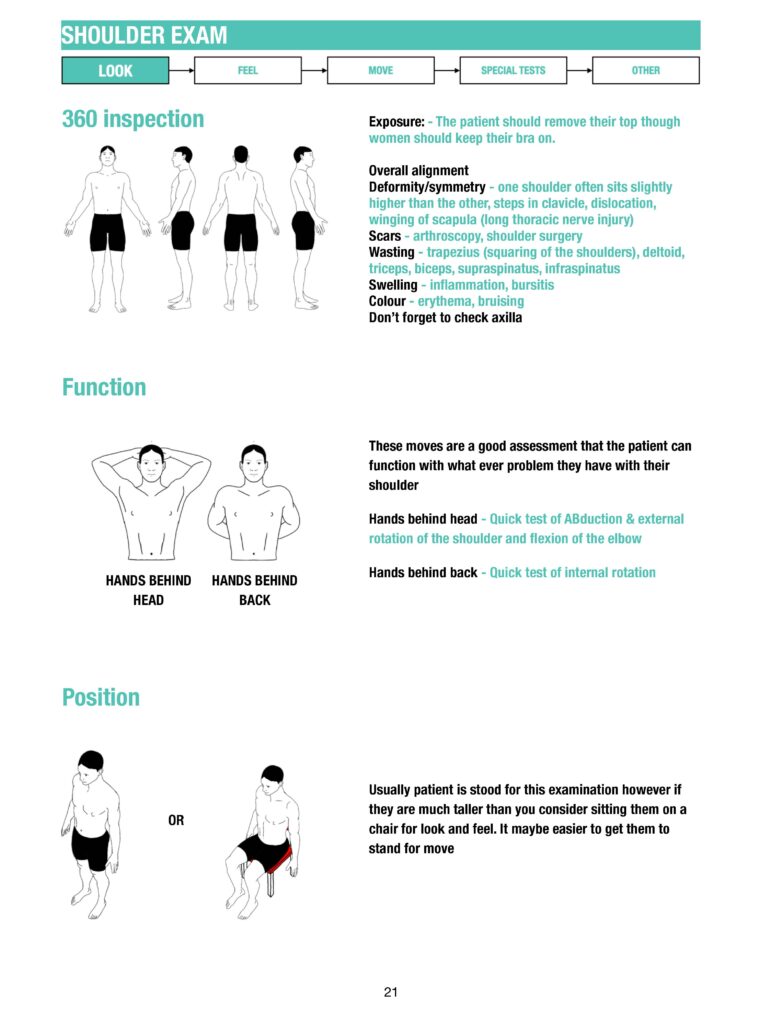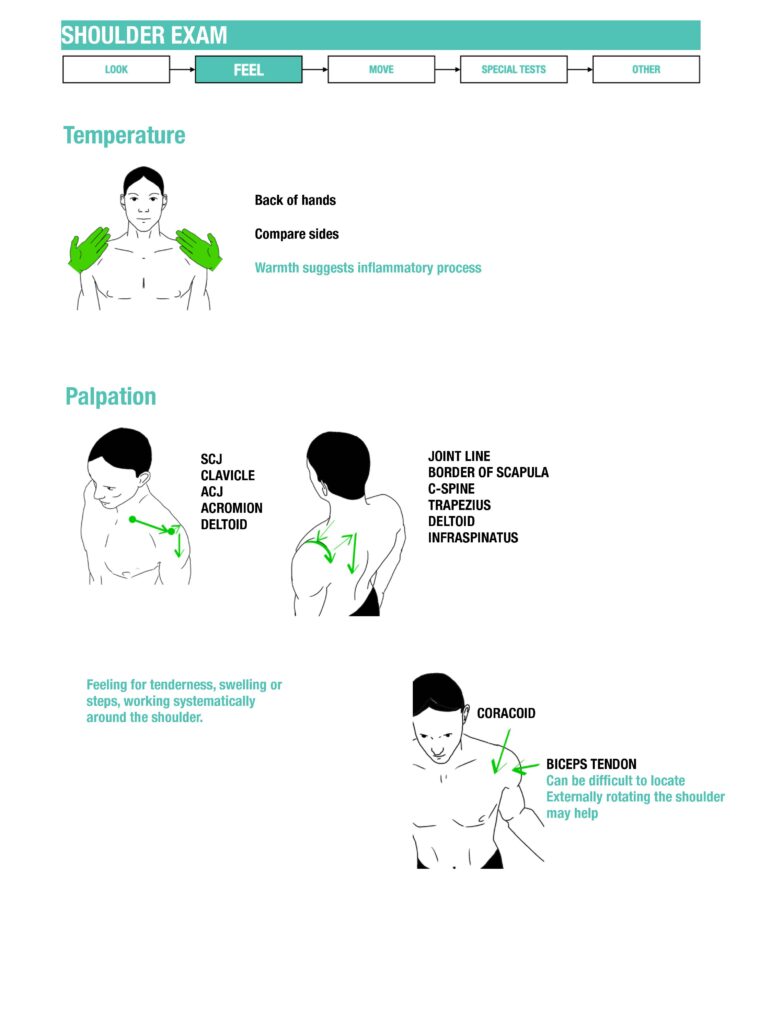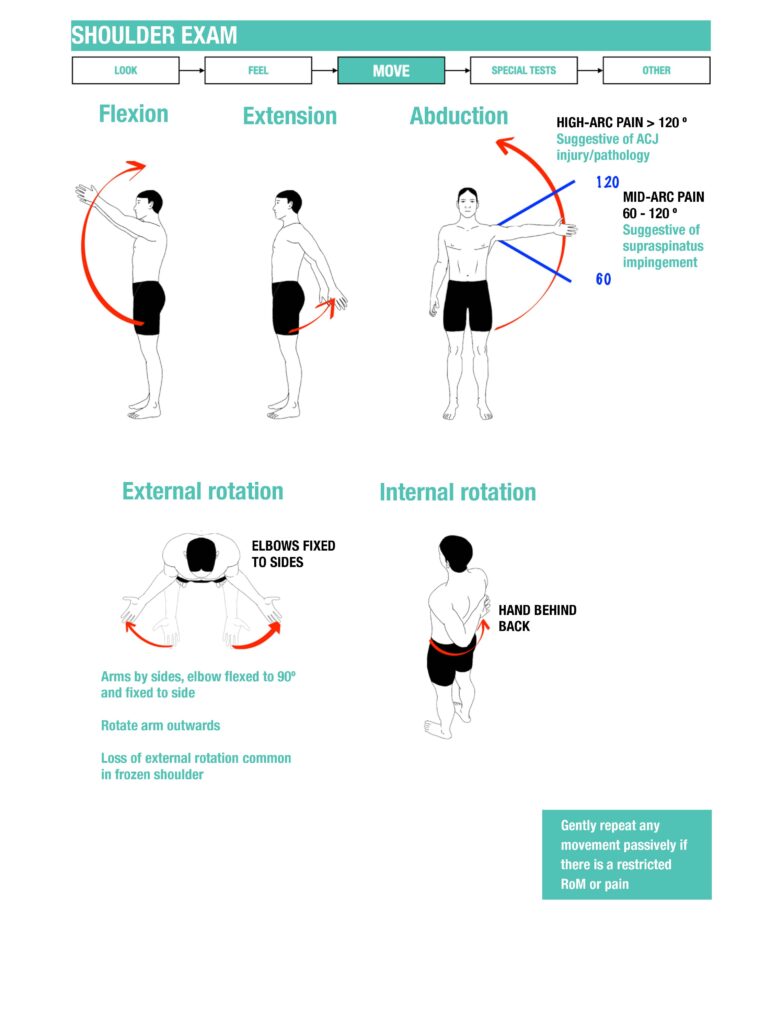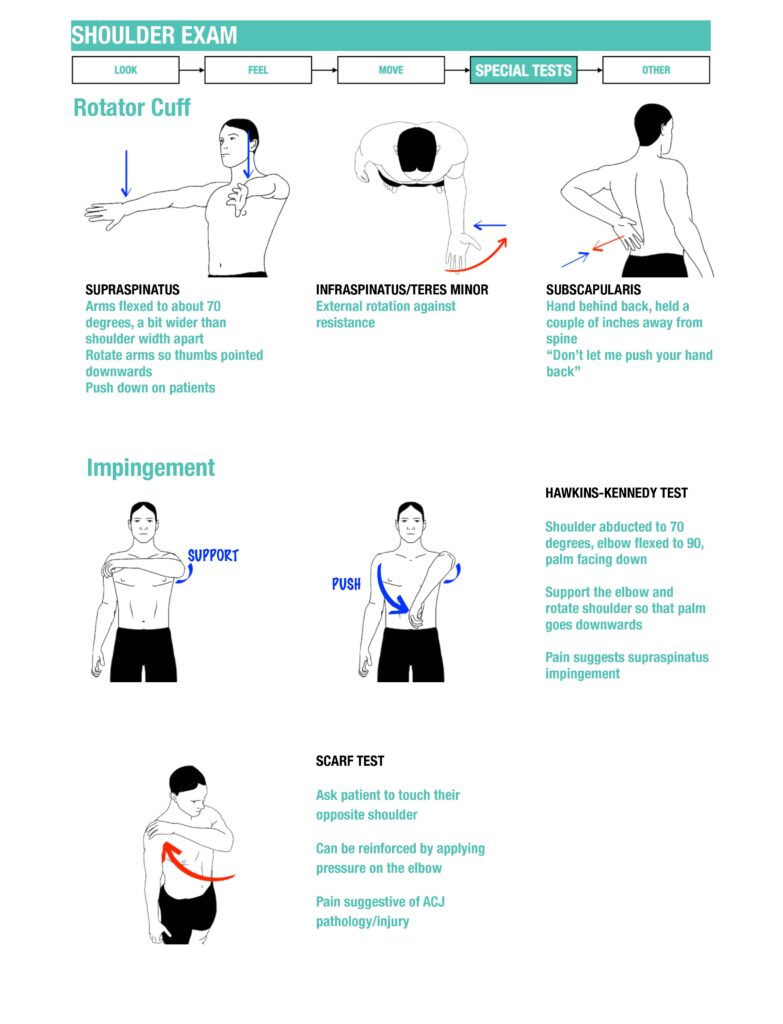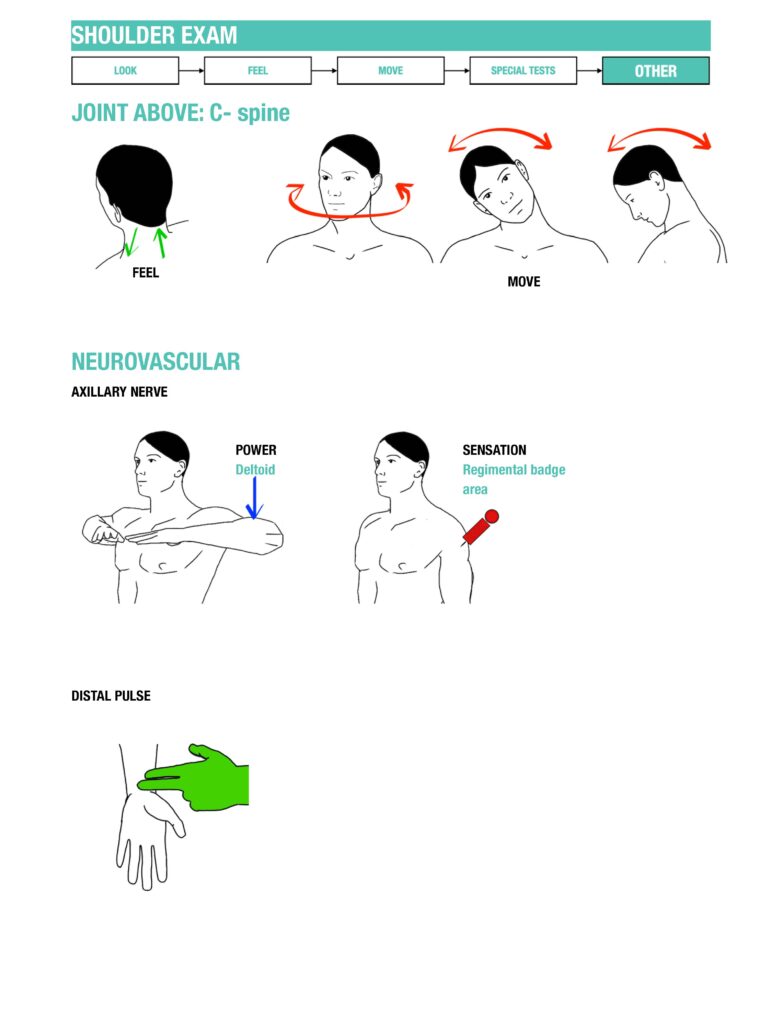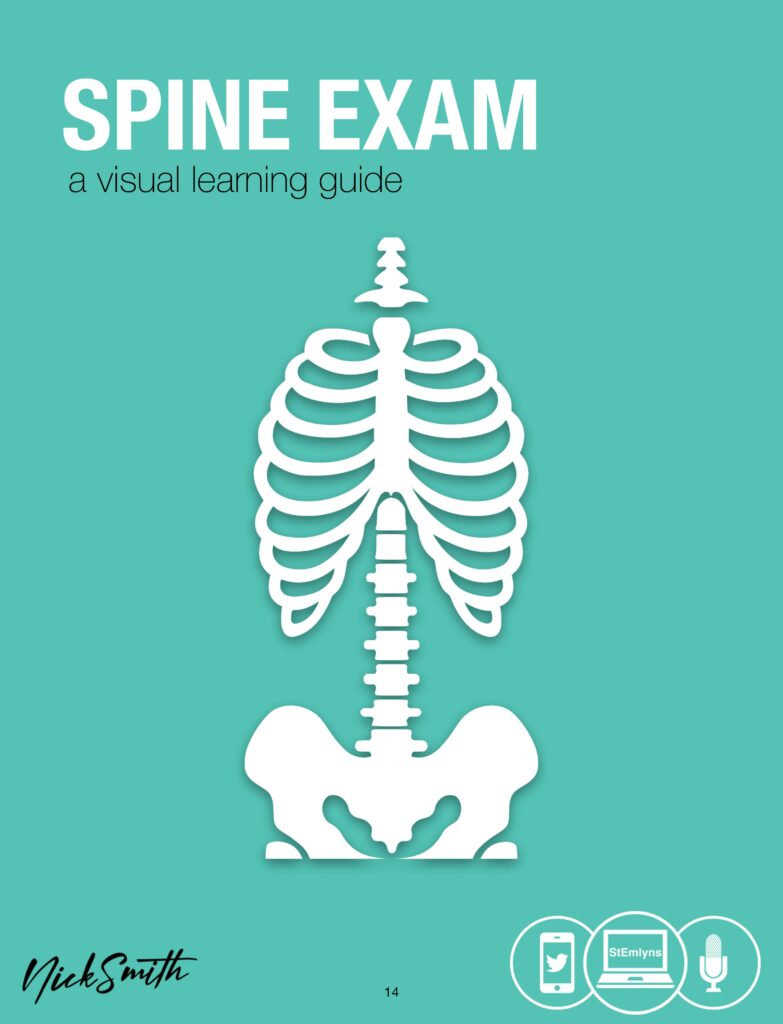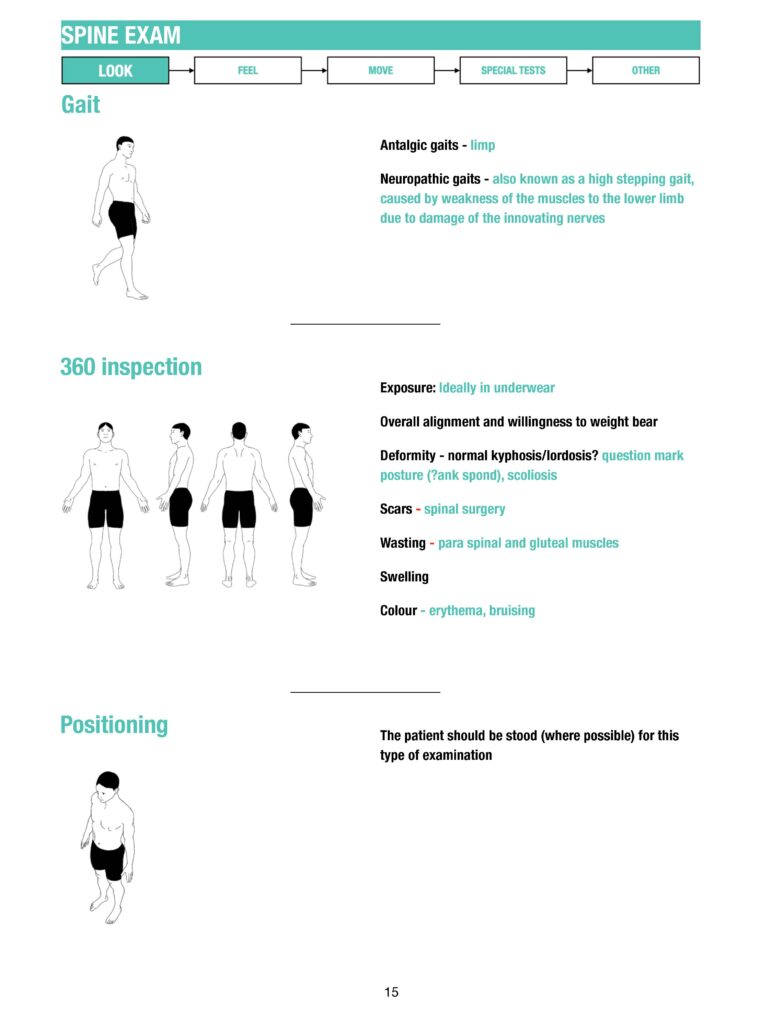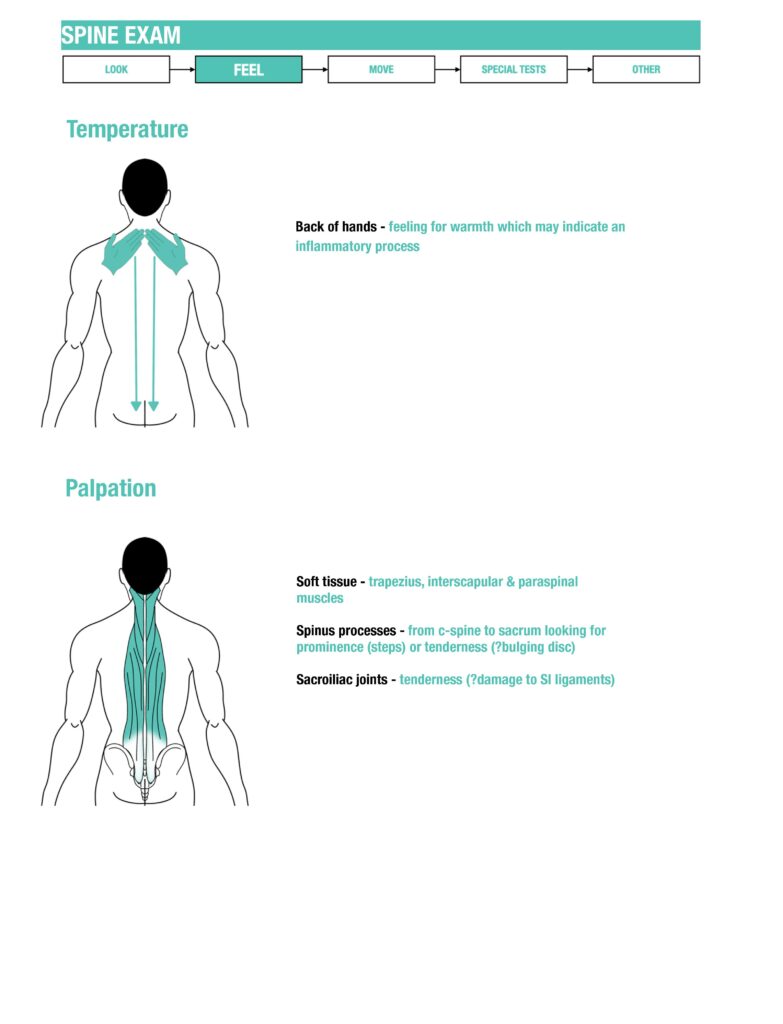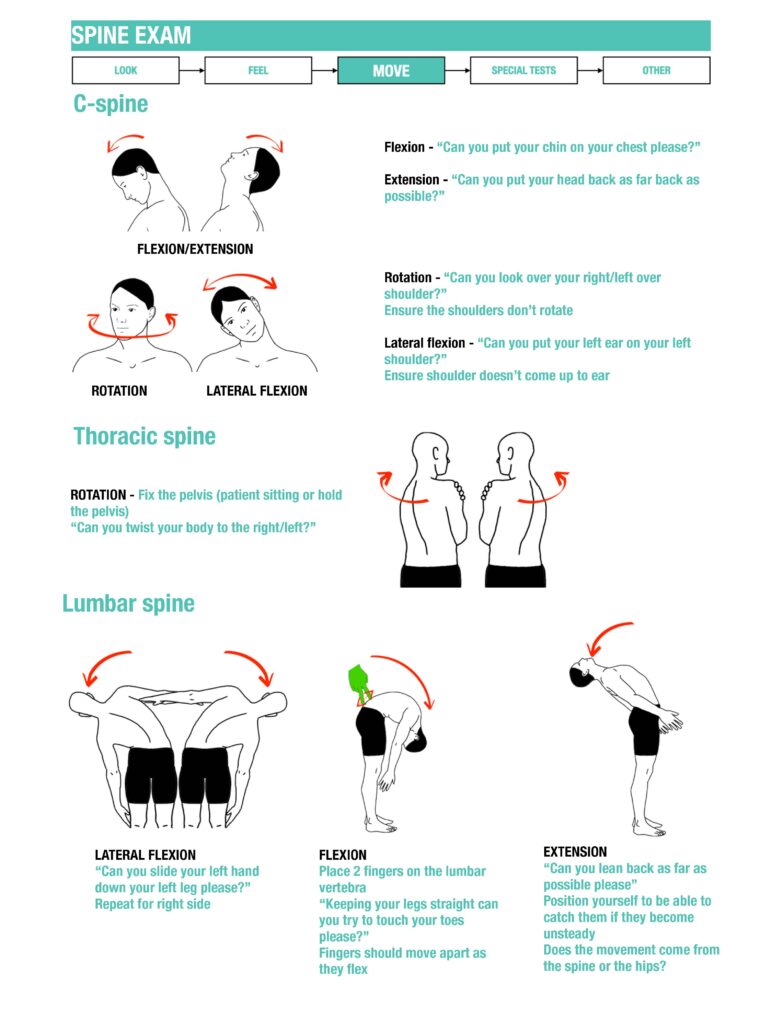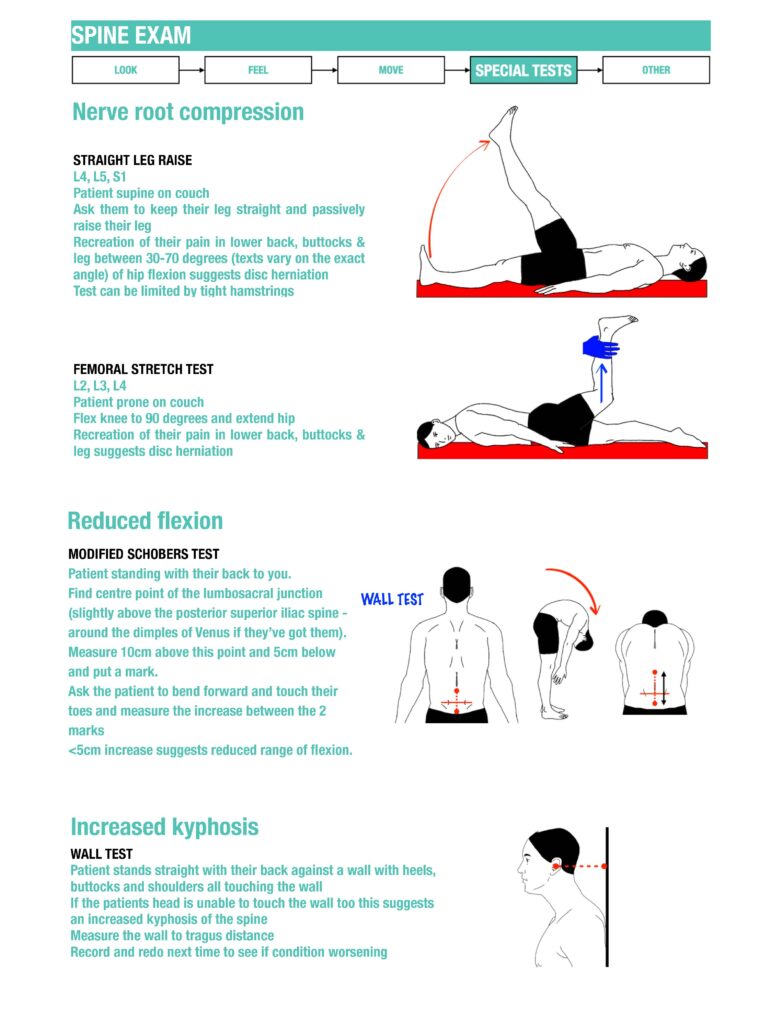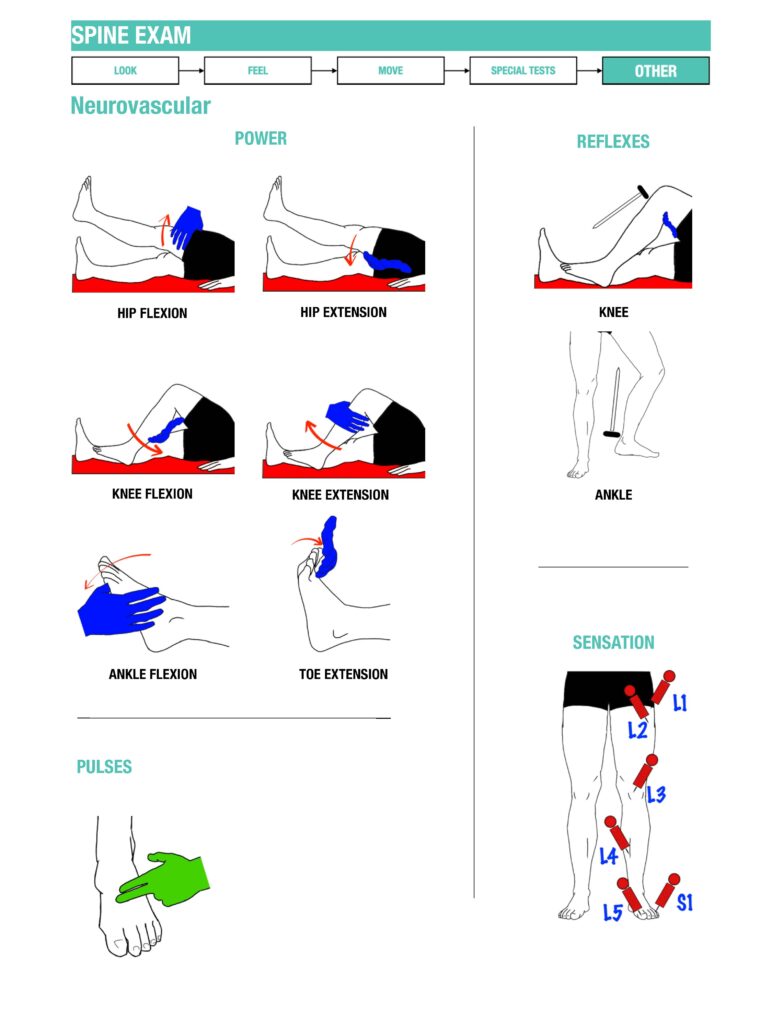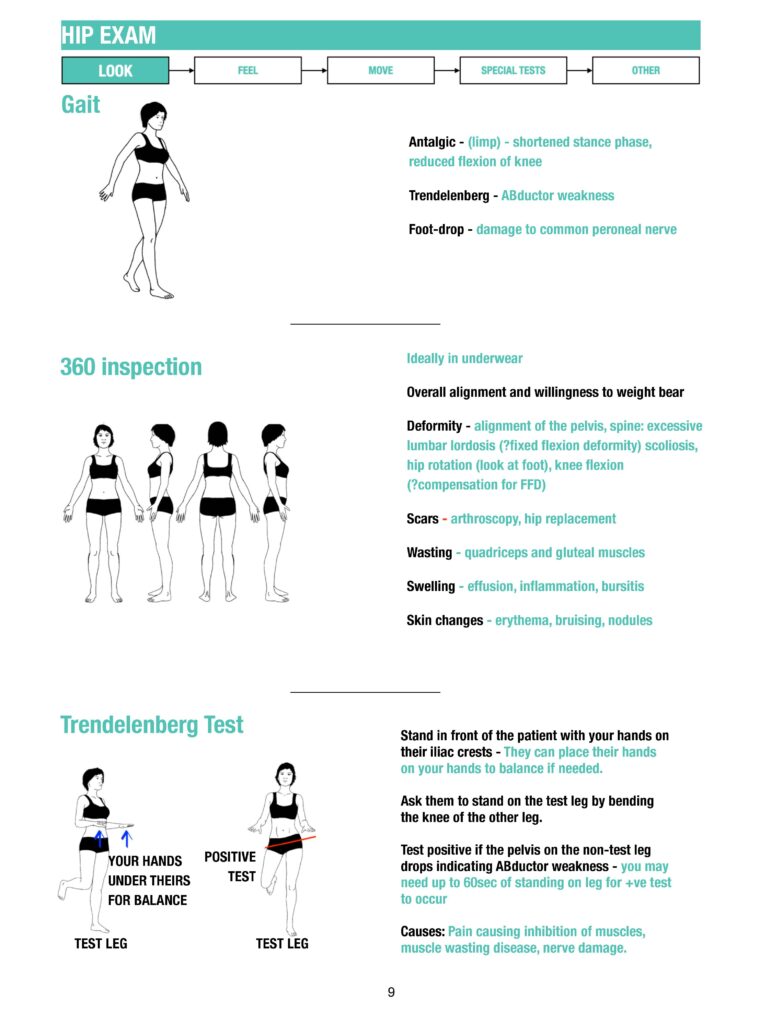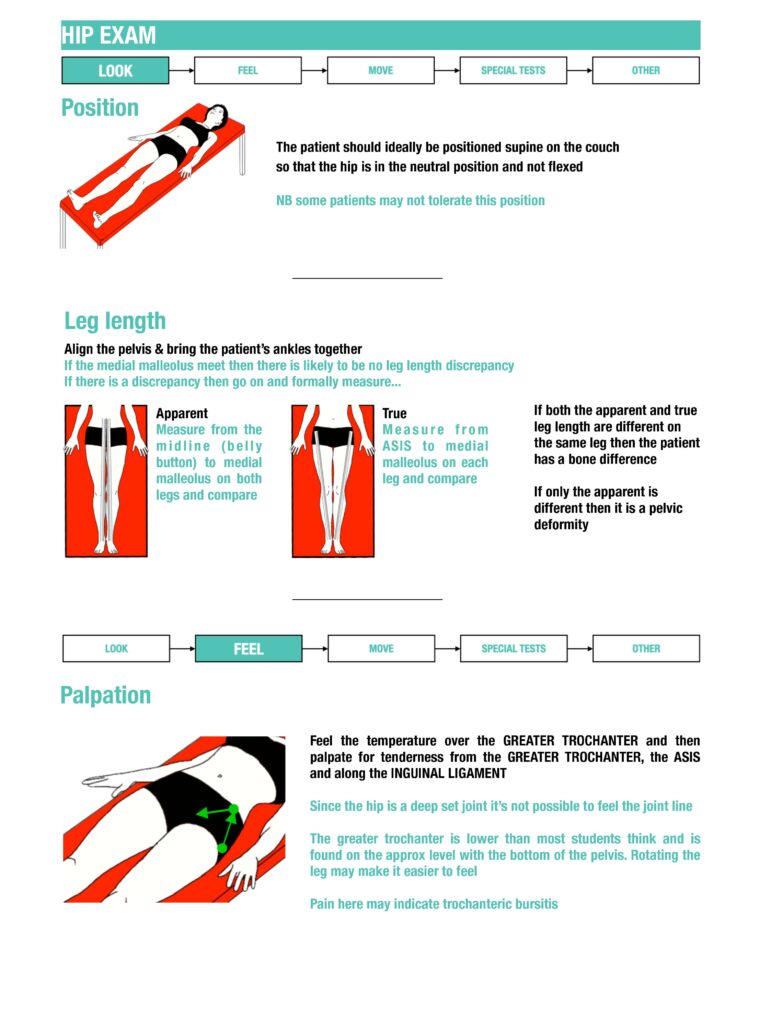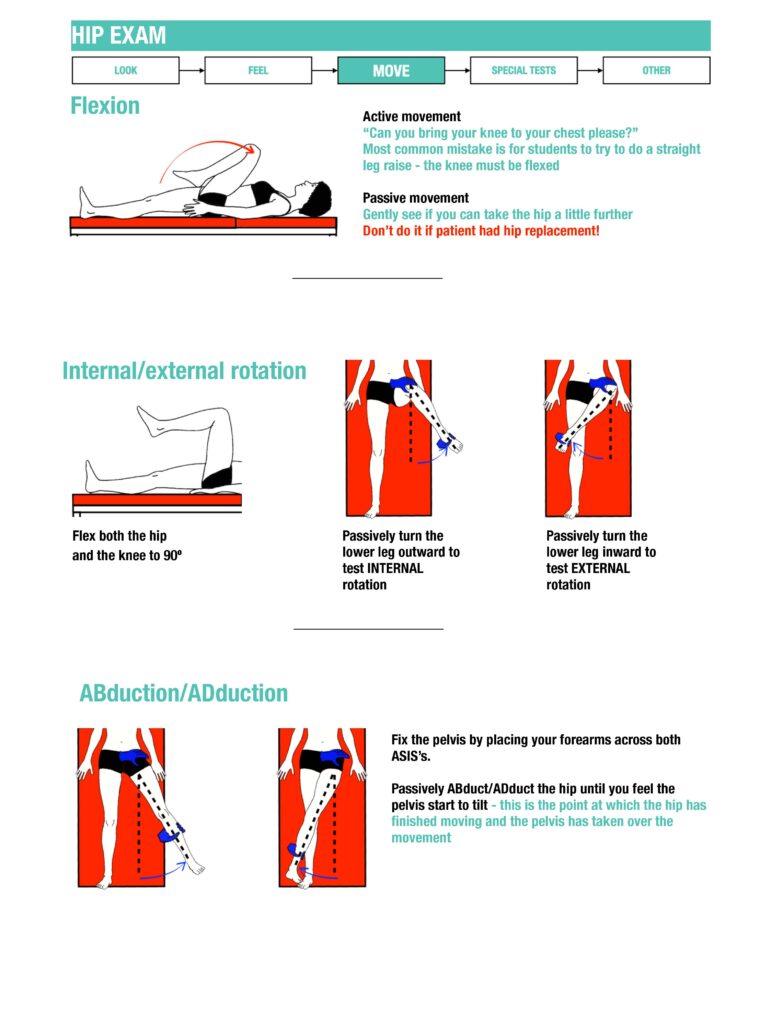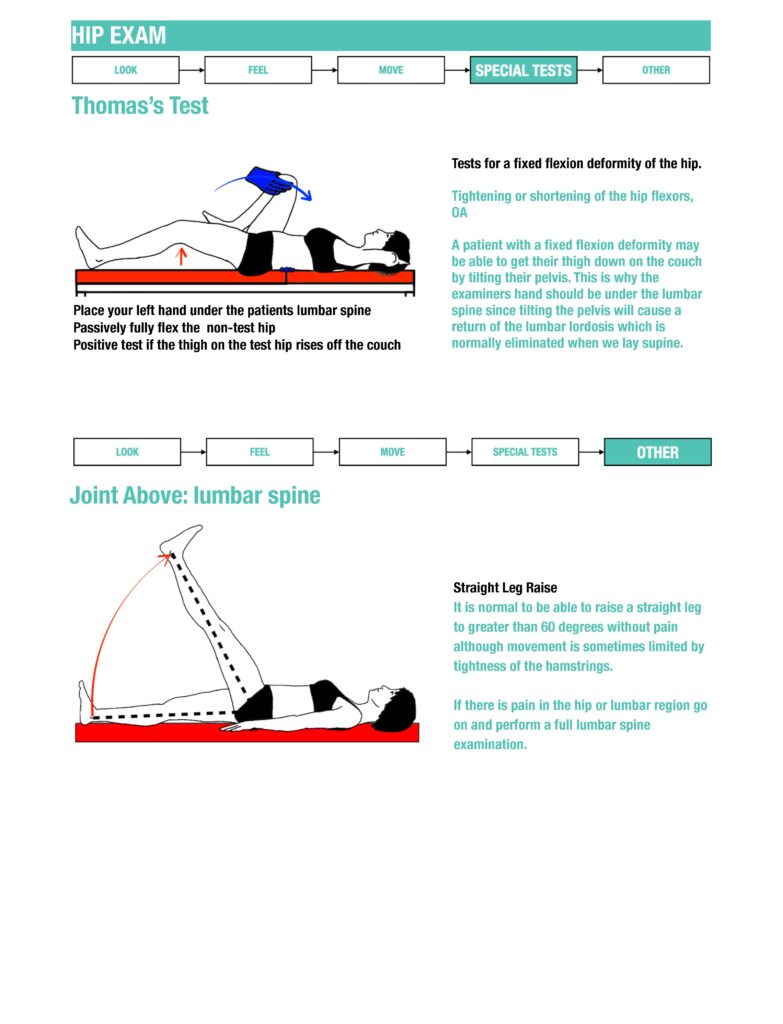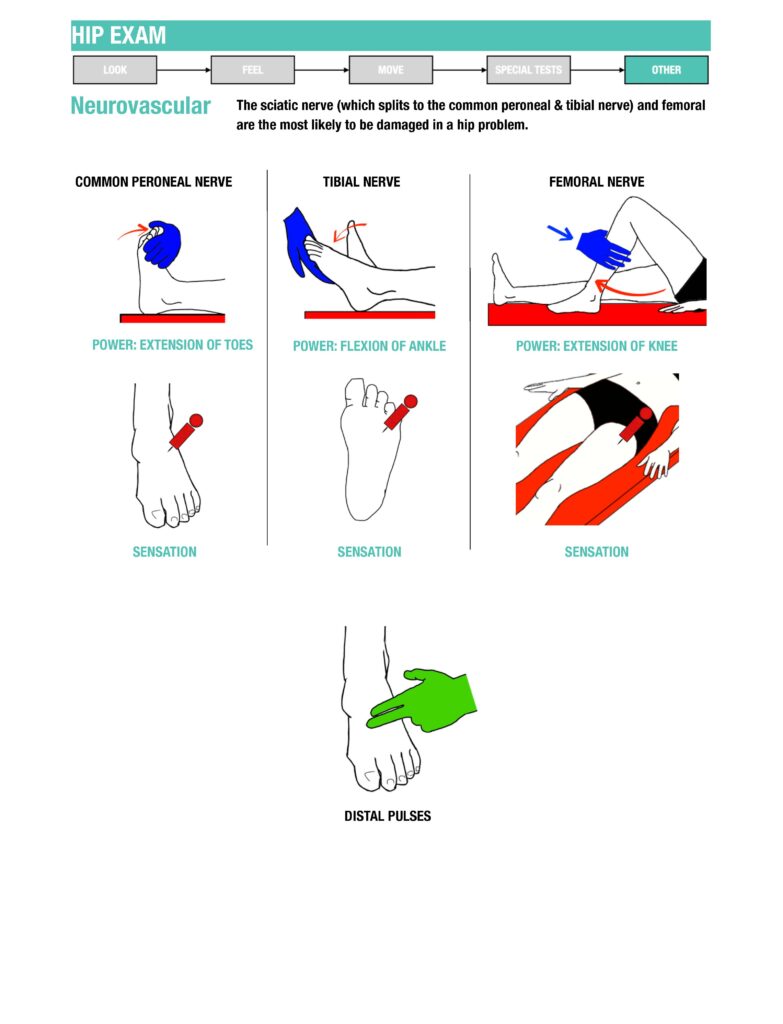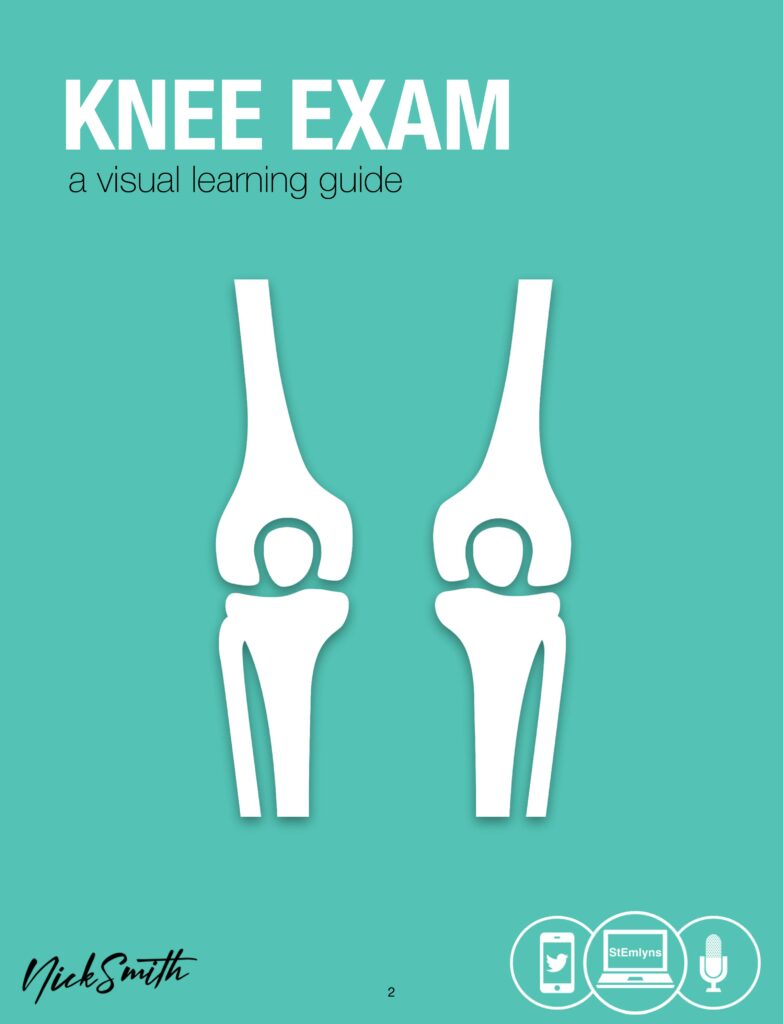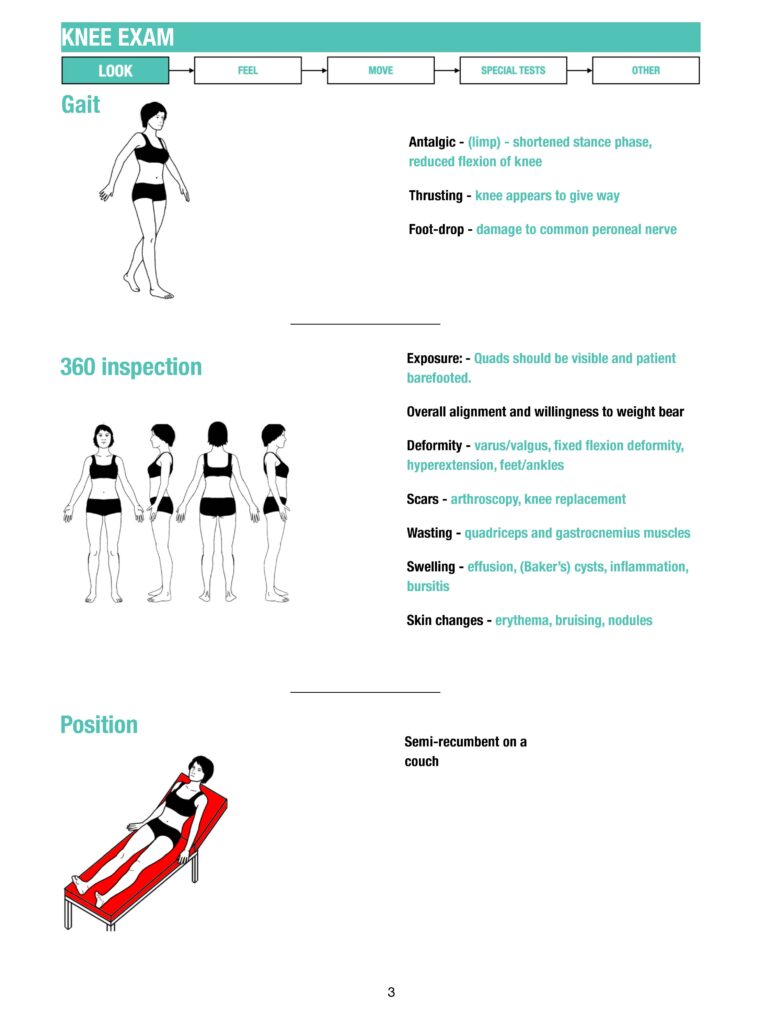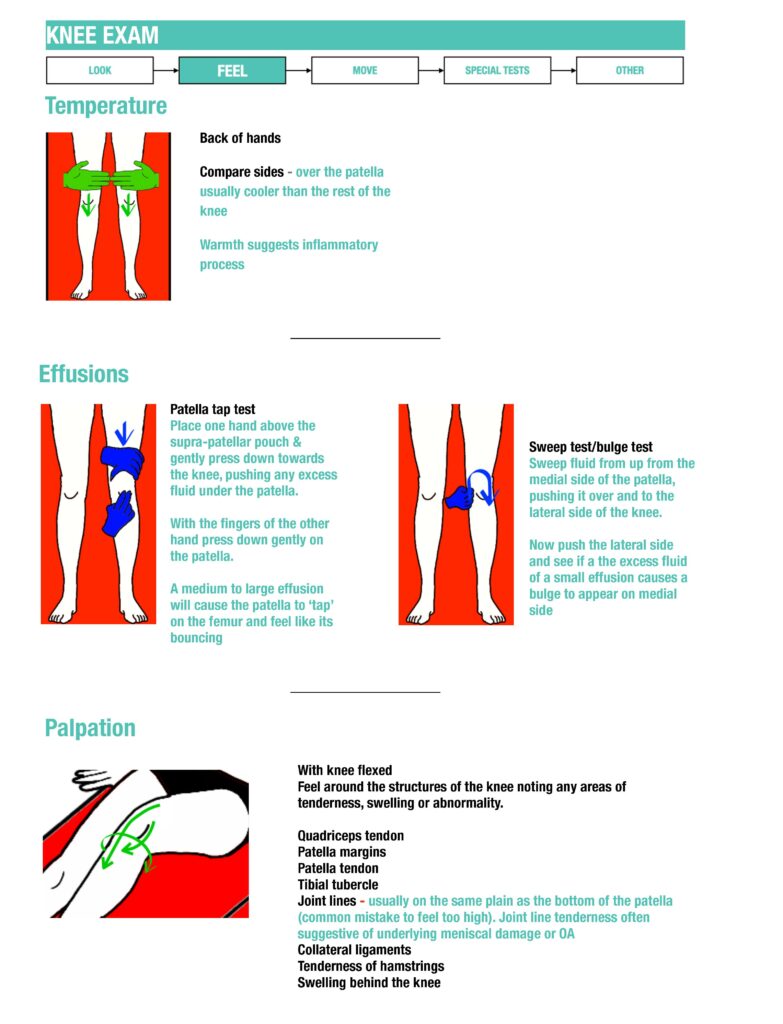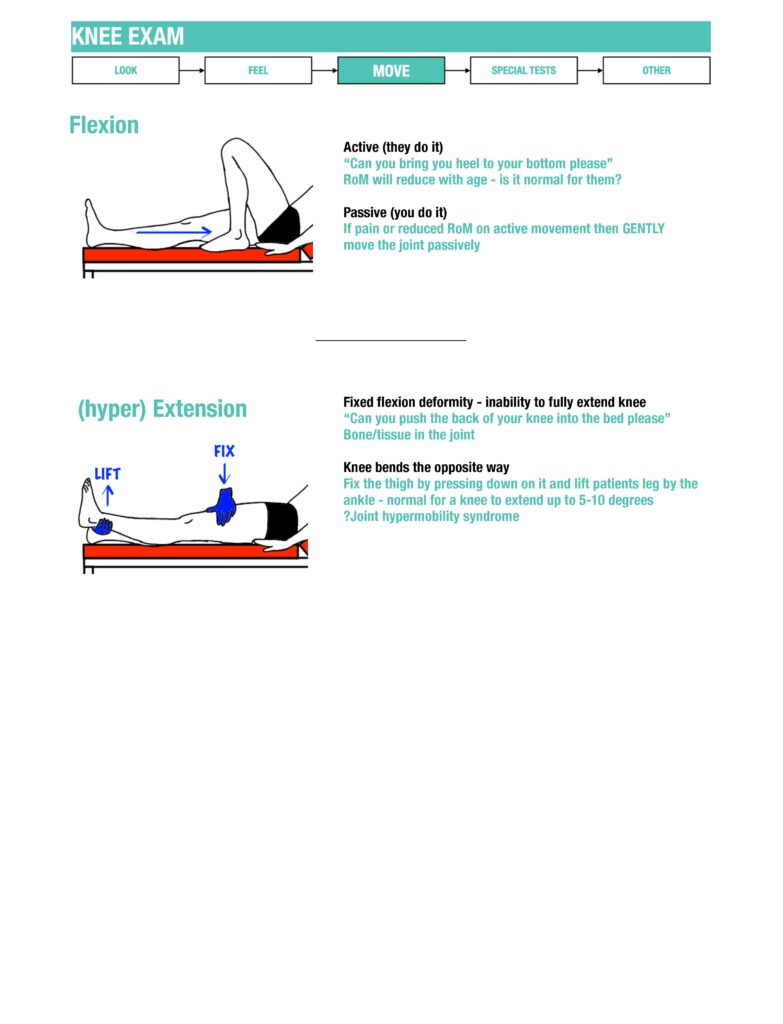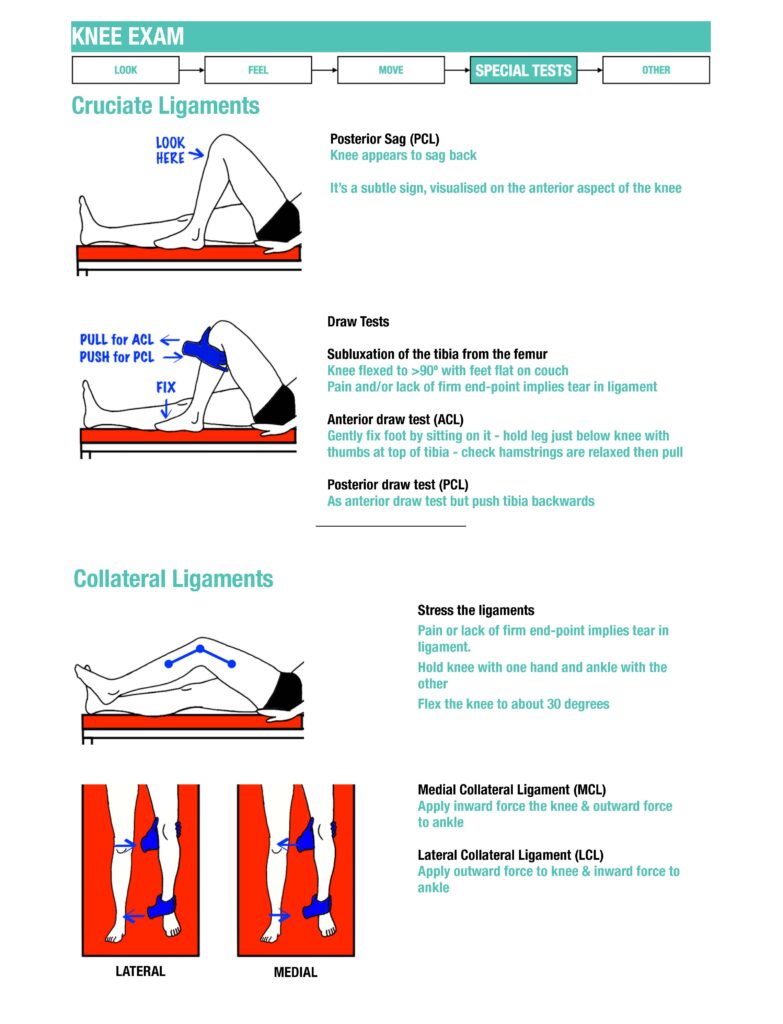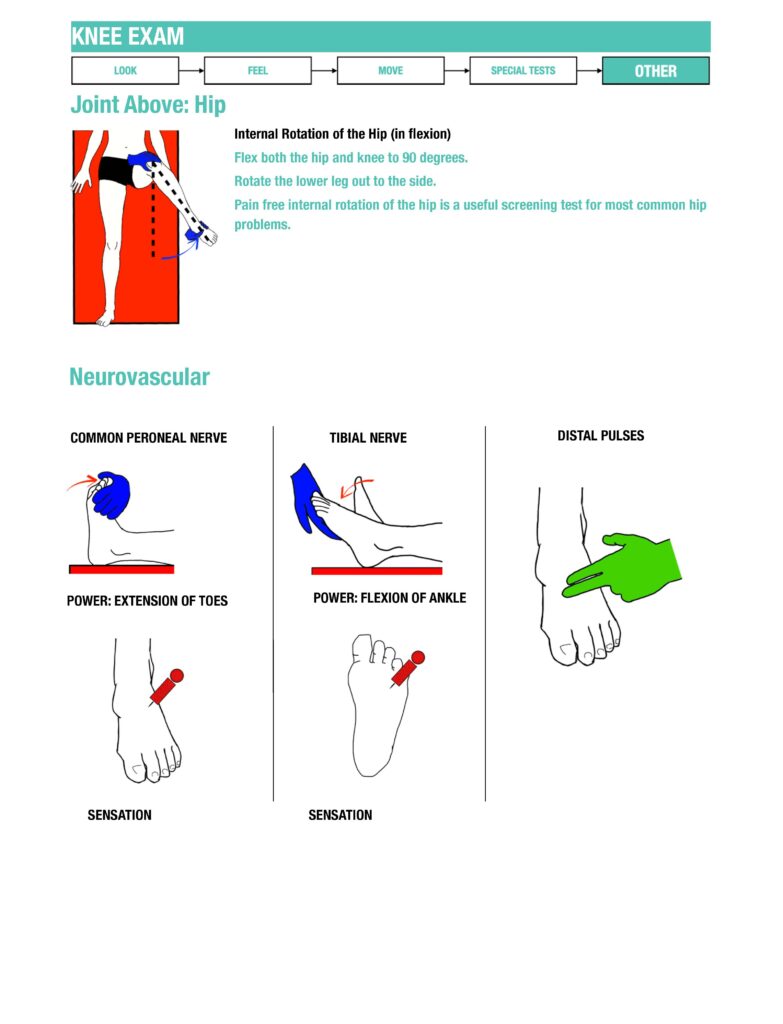Contents
| General tips | Elbow | Hip |
| Ensure you cover | Shoulder | Knee |
| Joint examinations | Neck | Ankle and foot |
| Hand and wrist | Back | GALS |
General Tips
Like all previous stations use your standard opening and closing scripts
Ensure you mention: privacy; appropriate exposure; analgesia and a chaperone
Ensure you cover
Brief history
- Mechanism of injury
- Hand dominance
- Occupation/recreational activities
- Tetanus status
Approach
- Gait
- Inspection: need to examine both sides; obvious deformity; swelling; erythema; scars
- Palpation: warmth; effusion
- Movement: active; passive; resisted
- Special tests: see below
- Neuro/vascular assessment: sensation; power; pulses; capillary refill
Joint examinations
Hand and Wrist
Script
Introduction
“Hello, my name is Phil. I am a medical student”
“Please can you confirm your name and date of birth, while I wash my hands, put on my PPE and ensure we are somewhere private.”
“Are you comfortable? Do you need any pain relief or a drink?”
“I have been asked to examine your hand/wrist. This will involve me looking at both your hands, wrists and elbows. I will be feeling these areas: testing the strength; the feeling, and doing some other tests. Is this ok with you?”
“Would you like a chaperone present?”
“Please can you ensure your arms from your elbows down are exposed and rest your hands on the table in front of you.”
“I will talk out loud as we go”
“If at any time you want me to stop or you are in pain, let me know”
Brief history
“Can you briefly tell me what the problem is?”
“Which hand do you write with?”
“What is your occupation?”
“Do you have special hobbies in which you use your hands?”
Lacerations:
- Have you had a tetanus injection within the last 10 years?
- Further questions to assess whether the wound is tetanus prone.
Inspection
- Check with examiner Do you want me to exam both hands? This would be my normal practice”
“Please place your hands palm down on the table.”
“I am inspecting the DORSUM hands for:
- Any gross: deformities; swellings; scars; wasting; contractures,
- For swelling in particular looking for any pattern of swelling (e.g. Rheumatoid arthritis: MCPJ/PIPJ)
- Nail changes: pitting; koilonychia; onycholysis; splinter haemorrhages”
‘Please turn your hands over, I am inspecting the PALMAR aspect of the hands for:
- any gross: deformities; swellings; scars; wasting; contractures
- for swelling in particular looking for any pattern of swelling (e.g. RA: MCPJ/PIPJ)
- nail changes: pitting; koilonychia; onycholysis; splinter haemorrhages
- palmar erythema
- the cascade”
“Please can you flex your fingers from your knuckles with your fingers straight. I am looking for rotational deformity or triggering.”
“Please can you bend your arm so I can look at your elbows: rheumatoid nodules; psoriatic plaques“
Palpation
“I am going to feel your hands, assessing for…”
- Warmth
- Capillary refill
- Radial pulse”
- Examiner: “Would you like me to do Allen’s test?”
Feel:
- ALL bones; joints and metacarpal squeeze
- Palm: thenar; hypothenar; midpalmar space and tendon sheaths
Move
Active; passive and resisted
WRIST:
- Flexion
- Extension
- Radial and ulnar deviation
- Supination and pronation
FINGERS:
Extensor tendons (hand palm down):
- MCPJ (extension)
- Extension of DIPJs (DP held in flexion of edge of table, “please straighten the tip of your finger”
Flexor tendons: (hand palm up) test each in turn
- FDP (flexes DIPJ): “I am going to isolate the PIPJ, please can you FLEX the TIP of your finger”(repeat with all)
- FDS (flexes PIPJ): “I am going to hold your fingers down but one. Please flex that finger from the knuckles.”
- Adduction and abduction
THUMB:
- Flexion
- Extension
- Opposition
- Abduction (up)
- Adduction (out to side)
- Ulnar collateral ligament: I am going to stabilise the carpometacarpal joint and stress the ligament either side.
MCPJ = metacarpophalangeal joint
FDP – flexor digitorum profundus
PIPJ = proximal interphalangeal joint
FDS – flexor digitorum superficialis
DIPJ = distal interphalangeal joint
Special tests
Finkelstein’s test: De Quervain’s tenosynovitis (inflamed abductor pollicis longus and extensor pollicis brevis)
- Close your fingers around you thumb then ulna deviate
- Pain over radial side of wrist suggests tenosynovitis
Radial nerve
- Sensation: Webspace; dorsum
- Motor: Wrist and finger extension; thumbs ‘up’
Median nerve
- Sensation: Dorsal fingers (apart from little and ½ ring)
- Motor: ‘ok’ sign (anterior interosseous nerve); make a fist
Special tests:
- Phalen’s – ain in the median nerve distribution after the inverted prayer position for 30 seconds.
- Tinel’s – Pain in the median nerve distribution after tapping over the median nerve. This is found between palmaris longus and flexor carpi radialis
Ulnar nerve:
- Sensation: lateral one and half fingers (ring/little)
- Motor: Resist adduction; cross fingers over
- Froment’s sign: Place paper between the thumb and index finger and ask the patient not to let you pull it out. Flexion of the thumb is a positive test and suggests ulnar nerve weakness.
Functional assessment
- Grasp cup
- Pinch something
- Grip strength
- Hook – yours and patients fingers together and try to straighten against resistance.
Close
“Thank you Mr X. That is the end of the examination.”
“Do you need any help getting dressed?”
“To complete my examination I would like to…”
- examine the joint above (elbow)
- examine neurovascular status (if not done)
“My working diagnosis is… I think we should do …”
“Does this sound reasonable to you? Do you have any questions or concerns?”
Additional Resources
Elbow
Script
Introduction
” Hello, my name is Phil. I am a medical student .”
“Please can you confirm your name and date of birth, while I wash my hands, put on my PPE and ensure we are somewhere private.”
“Are you comfortable? Do you need any pain relief or a drink?”
“I have been asked to conduct an examination of your elbow. This will involve me looking at both elbows: looking; feeling; moving them and assessing your strength and the sensation. Would that be ok with you?”
“Would you like a chaperone present?”
“Are you ok to ensure the whole of both your arms are visible please?”
“I will talk out loud as we go”
“If at any time you want me to stop or you are in pain, let me know”
Brief history
“Can you briefly tell me what the problem is?”
“Which hand do you write with?”
“What is your occupation?”
“Do you have special hobbies?”
Inspection
“Please can you stand up and face me, with your arms out by your sides, palms facing forward.”
“I am inspecting from front; back and sides looking for…”
- scars
- deformity including: swelling; bruising; redness (note normal slight valgus position)
- hyperextension
- wasting
- fasciculations
- rheumatoid nodules
Assess for a normal carrying angle by flexing the arms at the elbow
Palpation
“I am going to feel your elbows, assessing for…”
Comment on:
- warmth
- swelling
- bogginess
- crepitus in movement
- pain
Structures:
- medial epicondyle
- olecranon
- lateral epicondyle
- elbow flexed: radial head (thumb on head, supinate and pronate)
- biceps tendon (hook test)
- brachial and radial pulse
Move
Active; passive and resisted
- Flexion
- Extension
- Supination and pronation (flexed elbow; thumbs up and thumbs down)
Special tests
Radial nerve
- Sensation: webspace; dorsum
- Motor: Wrist and finger extension; thumbs ‘up’
Median nerve
- Sensation: dorsal fingers (apart from little and ½ ring)
- Motor: ‘ok’ sign (anterior interosseous nerve); make a fist
Ulnar nerve:
- Sensation: lateral one and half fingers (ring/little)
- Motor: Resist adduction; cross fingers over
- Froment’s sign: Place paper between the thumb and index finger and ask the patient not to let you pull it out. Flexion of the thumb is a positive test and suggests ulnar nerve weakness.
Lateral epicondyle tendinopathy (tennis elbow) = EXTENSORS
- Wrist extension against resistance
- stabilise arm at 90o in supination
- palpate lateral epicondyle
- patient makes fist and extends whilst you apply resistance
- pain over lateral epicondyle suggests a positive test
Medial epicondyle tendinopathy (golfer’s elbow) = FLEXORS
- Wrist flexion against resistance
- stabilise arm at 90o in supination
- palpate medial epicondyle
- patient makes fist and flexes wrist against resistance you apply
- pain over medical epicondyle suggests a positive test
Close
“Thank you Mr X. That is the end of the examination.”
“Do you need any help getting dressed?”
“To complete my examination I would like to…”
- examine the joint above and below (wrist and shoulder)
- examine neurovascular status (if not done)
“My working diagnosis is… I think we should do …”
“Does this sound reasonable to you? Do you have any questions or concerns?”
Additional Resources
Shoulder
Script
Introduction
” Hello, my name is Phil. I am a medical student .”
“Please can you confirm your name and date of birth, while I wash my hands, put on my PPE and ensure we are somewhere private.”
“Are you comfortable? Do you need any pain relief or a drink?”
” I have been asked to conduct an examination of your shoulder. This will involve me looking at both shoulders: looking; feeling; and moving them and assessing your strength and the sensation. Would that be ok with you?”
“Would you like a chaperone present?”
“Are you ok to ensure the whole of both your arms are visible please?”
“I will talk out loud as we go”
“If at any time you want me to stop or you are in pain, let me know”
Brief history
“Can you briefly tell me what the problem is?”
“Which hand do you write with?”
“What is your occupation?”
“Do you have special hobbies?”
Inspection
“Please can you stand up and face me, with your arms out by your sides, palms facing forward.”
“I am inspecting from the front; back; sides and axilla looking for…”
- scars
- deformity including: swelling; bruising; redness (note normal slight valgus position)
- hyperextension
- wasting
- fasciculations
Palpation
“I am going to feel your shoulders. I am palpating..”
Anteriorly: SCJ → Clavicle → Acromoclavicular joint → coracoid process → head of biceps tendon → greater tuberosity of humerus
Posteriorly: Acromion → spine of scapula → suprascapular and interscapular muscles
Move
Active; passive and resisted
- Flexion
- Extension
- Abduction
- Adduction
- Internal and external rotation
Stand from behind and stabilise scapular for all movements
Special tests
Rotator cuff
- Supraspinatus = abduction
- Subscapularis = internal rotation
- Infraspinatus and teres minor = external rotator
Supraspinatus – empty can
- flex shoulder 90o, abducted 30 with thumbs down
- push down against upper arm
- pain= positive test
Supraspinatus tear – drop test
- shoulder fully abduction (hands above head)
- lower arms slowly
- positive if at 90oarms drops (unable to control lowering)
Subscapularis tear- Gerber’s lift off
- internally rotate, dorsum resting on back
- apply resistance to palm and ask patient to lift hand off back
- weak life off suggests a positive test
Infraspinatus – resisted external rotation
- arms in, elbow flexed at 90
- externally rotate against resistance
- weakness suggests a tear;
- pain suggests impingement
Impingement – Neer’s test
- Pronate arm (internal rotation)
- Passively flex arm up as far as poss
- anterior pain = positive test
Instability – Sulcus test
Stand to side
- Stabilise shoulder with one hands
- Apply downward traction of the arm at the level of elbow
- appearance of sulcus= positive test
Close
“Thank you Mr X. That is the end of the examination.”
“Do you need any help getting dressed?”
“To complete my examination I would like to…”
- examine the joint above and below (elbow and neck)
- examine neurovascular status (if not done)
“My working diagnosis is… I think we should do …”
“Does this sound reasonable to you? Do you have any questions or concerns?”
Additional Resources
- Shoulder examination 1, 2
- Shoulder anatomy
Neck and Spine
Neck
Introduction
” Hello, my name is Phil. I am a medical student .”
“Please can you confirm your name and date of birth, while I wash my hands, put on my PPE and ensure we are somewhere private.”
“Are you comfortable? Do you need any pain relief or a drink?”
“I have been asked to conduct an examination of your neck. This will involve me looking and feeling your neck, asking you to do some movements and assessing the strength and feeling in your arms. Would that be ok with you?”
“Would you like a chaperone present?”
“I will talk out loud as we go”
“If at any time you want me to stop or you are in pain, let me know”
Brief history
“Can you briefly tell me what the problem is?”
“Which hand do you write with?”
“What is your occupation?”
“Do you have special hobbies?”
- If traumatic state you would immobilise and use a decision tool (Canadian C-spine/NEXUS) to determine whether neck can be cleared or imaging required
Inspection
“Please can you stand up and face me, with your arms out by your sides, palms facing forward.”
“I am inspecting from front; back and sides looking for…”
- scars
- deformity including: swelling; bruising; redness (note normal slight valgus position)
- hyperextension
- wasting
- fasciculations
FACE for Horner’s syndrome (ptosis; miosis)
Palpation
“I am going to feel your neck…”
Comment on
- warmth
- swelling
- bogginess
- crepitus on movement
- pain
From behind and the side of patient
Anterior:
- Front of neck
- Supraclavicular fossae
- Carotid pulse
Posterior:
- Call vertebrae: occiput to upper thoracic region
- Midline
- Laterally (either side paraspinal muscles)
- Warmth
Move
Active; passive and resisted
- Flexion
- Extension
- Left and right lateral flexion (ear to shoulder)
- Left and right lateral rotation
Special tests
COMPRESSION
Hoffman’s test (upper motor neurone lesion)
- stabilise middle finger at proximal interphalangeal joint
- flick the distal tip
- if thumb and index finger flex and adduction suggests a positive test
Lhermitte’s test
- flexion or extension of the neck causes electric shock sensation in lower limbs
THORACIC OUTLET OBSTRUCTION
Adson’s test = loss of radial pulse or reproduces symptoms suggests thoracic outlet obstruction (brachial plexus AND subclavian artery can get compressed in the interscalene triangle)
- Arm: abducted to 90o and extended slightly
- Extend and rotate neck to the same side
- Ask the patient to hold their breath
- positive test if the radial pulse disappears.
- Test both sides
MENINGISM
Kernig’s
- Supine; flex hip/knee to 90o then extend knee
- positive test if pain in the back/neck on extension
Brudzinski’s
- Flexion of neck causing flexion of hips and knees
Upper limb neurology
Tone
“I am going to hold each of your hands and do some movements with them to assess your tone…” (Flexion; extension; supination and pronation at the elbow)
“I am assessing whether tone is increased, reduced or normal.”
Power
“I need to assess how strong you are by asking you to do some movements…”
Test the different muscle groups
| Shoulder abduction (deltoid) | C5 |
| Elbow extension (triceps) | C7 |
| Elbow flexion (biceps) | C6 |
| Wrist extension (extensor carpi U+R) | C7 |
| Wrist flexion (flexor carpi U+R) | C6 |
| Finger extension | C7 |
| Finger flexion | C8 |
| Finger: abduction; opposition; thumb to ceiling; thumb to middle finger | All T1 |
Sensation
“I need to test how well you can feel areas on your skin…”
- Can you feel here? (on upper chest)
- Bring you arms straight by your side with you palms facing forward (‘anatomical’ position).
- Please can you close your eyes and tell me when you feel something.
I will assess the different modalities of all dermatomes using:
- Light touch (cotton wool)
- Sharp/dull (neurotip)
- Vibration sense (128Hz tuning fork) (start + move up)
- Proprioception (joint position sense)
- Temperature
Relexes
“I need to assess your reflexes, I will use the tendon hammer to assess them…”
“I need to assess your reflexes, I will use the tendon hammer to assess them…”
“Try and relax your arm, I am going to…”
- tap in the crook of your elbow (biceps: C5-6))
- tap on your lower arm just above your wrist on the side where the thumb is (brachioradialis: C6-7)
- to support your arm by interlocking my fingers with yours allowing your elbow to hang down, and tap just above the elbow (triceps: C7-C8)
- You may want to ask the patient to re-enforce the reflexes by clenching their teeth, hooking together their flexed fingers and trying pull them apart.
Coordination
“I need to assess your co-ordination…”
- With your index finger can you touch your nose and then my finger? Keep going back and forth and try to keep following my finger. I will keep my finger still. Please continue with your eyes closed (finger-nose).
- Close your eyes and extend your arms up to the ceiling, palms up and keep them there (pronator drift).
- Can you place your hand into your palm and then move your hand back to front as quickly as you can. Please repeat on the other side (dysdiadochokinesia).
Close
“Thank you Mr X. That is the end of the examination.”
“Do you need any help getting dressed?”
“To complete my examination I would like to…”
- examine the joint below (shoulder)
- examine neurovascular status (if not done)
“My working diagnosis is… I think we should do …”
“Does this sound reasonable to you? Do you have any questions or concerns?”
Additional Resources
- Spine examination
- Canadian C spine rules
- Nexus decision rule
- NICE Imaging algorithm (covers head and cervical spine)
- NICE Spinal injury: assessment and initial management
- C-spine injury: Immobilisation (initial assessment of the trauma patient)
- C-spine injury: Collar application (initial assessment of the trauma patient)
- Neck anatomy
Back
Introduction
” Hello, my name is Phil. I am a medical student .”
“Please can you confirm your name and date of birth, while I wash my hands, put on my PPE and ensure we are somewhere private.”
“Are you comfortable? Do you need any pain relief or a drink?”
“I have been asked to conduct an examination of your back. This will involve me looking at your back, feeling along the spine, and asking you to do some movements. Would that be ok with you?”
“Would you like a chaperone present?”
“I will talk out loud as we go”
“If at any time you want me to stop or you are in pain, let me know”
Brief history
“Can you briefly tell me what the problem is?”
“What is your occupation?”
” Do you have special hobbies?”
YOUNGER: history of back problems at young age; ‘6A’s’ of ankylosing spondylitis: atlanto-axial subluxation; anterior uveitis; apical fibrosis; aortic regurgitation; amyloidosis (renal); achilles involvement (enthesitis)
OLDER: weight loss; pain at night; history of active or previous cancer
Inspection
“Please could you stand up and face me. Could you briefly stand on each leg” (Allows gross assessment of power)
“I am inspecting from front; back and sides looking for…”
- Side: normal cervical and lumbar lordosis; thoracic kyphosis
- Back: scoliosis, scars, natal cleft
- Redness
Palpation
“I am going to gently feel all the bones along your spine, as well as the muscles either side.”
Comment on:
- warmth
- swelling
- bogginess
- crepitus in movement
- pain
- widened spinous processes
All vertebrae: cervical; thoracic; lumbar spine on both sides
Move
- Flexion
- Extension
- Rotation
- Lateral flexion
Special tests
Schober’s – fixed lumbar flexion
- Measure 5 cm below sacral dimples (iliac crest) and 10cm above
- Patient flexes with legs straight
- Re-measure distance between the two,
- Normal is 20cm; less the 20cm suggest fixed lumbar flexion
Sciatic stretch test (straight leg raise)
- lift straight leg passively
- positive test is suggested by reproduction of pain in sciatic nerve root distribution (if after 10o)
Well leg raise test – large central disc prolapse
- Straight leg raise on normal side causes radicular pain in affected leg
Bowstring – sciatic root entrapment
- Straight leg raise until symptoms
- Flex knee = pain better
- Apply pressure behind lateral femoral condyle to stretch common peroneal nerve
- positive test = neuropathic pain
Faber- ankle flexed; abduction and externally rotated with ankle placed on knee
- Stabilise opposite ASIS
- Downward pressure in flexed knee
- Positive test is suggested if there is pain in the hip
- Anterior pain suggests osteoarthritis,
- Posterior pain = Sacroiliac
ASIS = anterior-superior illiac spine
Femoral stretch test – femoral nerve irritation
- Prone, flex knee
- pain + paresthesia in anterior thigh on flexion is a positive test
Close
“Thank you Mr X. That is the end of the examination.”
“Do you need any help getting dressed?”
“To complete my examination I would like to…”
- examine the joint below (hip)
- abdominal examination
- PR examination to assess tone and sensation
- examine neurovascular status (if not done)
“My working diagnosis is… I think we should do …”
“Does this sound reasonable to you? Do you have any questions or concerns?”
Additional resources
Hip
Script
Introduction
” Hello, my name is Phil. I am a medical student .”
“Please can you confirm your name and date of birth, while I wash my hands, put on my PPE and ensure we are somewhere private.”
“Are you comfortable? Do you need any pain relief or a drink?”
“I have been asked to conduct an examination of your hip. This will involve me looking at both hips; your walking and assessing the movement. Would that be ok with you?”
“Would you like a chaperone present?”
“I will need to see both your legs; are you able to change into shorts? “
“I will talk out loud as we go”
“If at any time you want me to stop or you are in pain, let me know”
Brief history
- Examiner: “Do you want me to examine both hips? This would be my normal practice.”
“Can you briefly tell me what the problem is?”
“What is your occupation?”
“Have you been involved in any trauma?”
“Have you had any previous operations on your hips?”
“Have you had a fever?”
Gait
“Please could you walk up and down the room. I am examining for any gait abnormalities, such as…”
- antalgic gait
- Trendelenburg gait
- foot drop
Inspection
“Please can you stand up and face me, with your arms out by your sides, palms facing forward.”
“I am inspecting from front; back and sides looking for…”
- scars
- wasting
- fasciculations
EXTENSION: active; passive; resisted
Trendelenberg test:
- Kneel in front of the patient
- Patient told to rest hands on shoulders for support
- Examiner palpates both anterior superior illiac spines
- Patient stands on one leg and repeat on the other side
- Positive test is suggested if pelvis tilts when standing on affected side due to weak hip abductors
Palpation
“Please can you lie down on the couch. I need to feel the hip for…”
Comment on:
- warmth
- swelling
- bogginess
- crepitus in movement
- pain
“I am also feeling for the following structures..:
- iliac crest
- anterior superior illiac spines (ASIS)
- ischial tuberosities (rami)
- greater trochanter
- lesser trochanter
True and apparent leg length
- True = ASIS to medial malleolus
- Apparent = umbilicus to medial malleolus
Correct pelvic tilt first (line between both ASIS should be perpendicular)
Move
Active, passive, resisted
- flexion
- extension (push heels into bed) if not done earlier
- abduction
- adduction
- internal and external rotation
Special tests
Thomas’- fixed flexion deformity of hip
- Hand under lower back, to exaggerate lordosis
- “Bring knee into chest and hold it there”
- positive test if the opposite leg flexes
Sciatic stretch test (straight leg raise)
- lift straight leg passively
- positive test = pain in sciatic nerve root distribution (if after 10o)
Faber- ankle flexed; abduction and externally rotated with ankle placed on knee
- Stabilise opposite ASIS
- Downward pressure in flexed keen
- positive test = pain in hip
- Anterior pain = OA, Posterior pain = Sacroiliac
Close
“Thank you Mr X. That is the end of the examination.”
“Do you need any help getting dressed?”
“To complete my examination I would like to…”
- examine the joint below (spine and knee)
- PR examination to assess tone and sensation
- examine neurovascular status (if not done)
“My working diagnosis is… I think we should do …”
“Does this sound reasonable to you? Do you have any questions or concerns?”
Additional resources
- Hip examination 1; 2
- Paediatric hip – disorders
- Limping child: pathway; limping child; fever and limp
- Hip anatomy
Knee
Script
Introduction
” Hello, my name is Phil. I am a medical student .”
“Please can you confirm your name and date of birth, while I wash my hands, put on my PPE and ensure we are somewhere private.”
“Are you comfortable? Do you need any pain relief or a drink?”
“I have been asked to conduct an examination of your knee. This will involve me looking at both knees: how you are walking and assessing the movement and strength. Would that be ok with you?”
“Would you like a chaperone present?”
“I will need to see both your legs, are you able to change into shorts? “
“I will talk out loud as we go”
“If at any time you want me to stop or you are in pain, let me know”
Brief history
- Examiner: my normal practice would be to examine both sides, do you want me to do this?
“Can you briefly tell me what the problem is?”
“What is your occupation?”
“Have you been involved in any trauma?”
“Have you had any previous operations on your knees?”
“Have you been unwell recently?”
Gait
“Please could you walk up and down the room. I am examining for any gait abnormalities, such as…”
- antalgic gait
- Trendelenburg gait
- foot drop
Inspection
“Please can you stand up straight. I am inspecting the hip from the front; back, and sides. I am looking for…”
- scars
- skin changes
- wasting
- muscle bulk of quadraceps
- deformity: varus (out); valgus (in)
- popliteal mass or swelling
Palpation
“Please can you lie down on the couch. I need to feel the knees for…”
Comment on:
- warmth – use the back of your hand to compare to the other side and rest of the leg
- swelling
- bogginess
- crepitus in movement
- pain
“I know need to palpate the joint line or any tenderness, and also assess for effusion”
- Knee flexed at 90o
- Start in the hollow next to medial part of patellar tendon
- Medial joint line → medial tibial plateau (inferiorly) → medial femoral condyle (superiorly) → quads tendon and muscles → lateral femoral condyle → lateral joint line → lateral tibial plateau → patella tendon → fibular head → patella
Effusion
- milk the knee → squeeze thigh and push towards feet
- maintain hold → apply pressure to medial, then later side → looking for a bulge
- Patella tap – larger effusion.
- Empty supra-patellar pouch → push down on patella sharply with thumb and index finger → tap + bounce back if effusion)
Move
Active; passive, resisted (with hand over patella to feel for crepitus)
- flexion
- extension
Special tests
Extensor mechanism
- straight leg raise
Patella apprehension test
- Extended leg, then flex while applying pressure on medial aspect of patella, trying to displace laterally
- Watch patient’s face
Anterior cruciate ligament
- Knees flexed at 90o feet forward
- Sit on patient’s foot
- place thumbs in popliteal fossa with thumbs on tibial tuberosity
- check hamstrings are relaxed
- pull with firm jerk
- positive if there is translocation forward
Posterior cruciate ligament
- Knees flexed at 90o feet forward
- Inspect for sagging of tibial condyle
Medial collateral ligament
- extended legs with knees 20-30o flexed
- one hand on lower leg (this pushes away from side being tested)
- hand outer part of knee, pushing medially, lower hand exerting pressure in opposite direction
- positive if there is joint opening
Lateral collateral ligament
- extended, knees in 20-30o flexed
- one hand on lower leg (this pushes away from side being tested)
- hand inner part of knee, pushing towards lateral side, while lower hand is exerting pressure in opposite direction
- positive if there is joint opening
McMurray’s test – meniscal injury
- Fully flex knee
- MEDIAL:
- Laterally rotate tibia (knee), then extend and flex the knee
- LATERAL:
- Medially rotate tibia (knee), then extend and flex the knee
- Positive if there is popping; cracking; pain
Close
“Thank you Mr X. That is the end of the examination.”
“Do you need any help getting dressed?”
“To complete my examination I would like to…”
- examine the joint above andbelow (hip and ankle)
- PR examination to assess tone and sensation
- examine neurovascular status (if not done)
“My working diagnosis is… I think we should do …”
“Does this sound reasonable to you? Do you have any questions or concerns?”
Additional Resources
Ankle and foot
Introduction
” Hello, my name is Phil. I am a medical student.”
“Please can you confirm your name and date of birth, while I wash my hands, put on my PPE and ensure we are somewhere private.”
“Are you comfortable? Do you need any pain relief or a drink?”
“I have been asked to conduct an examination of your ankle and foot This will involve me looking at both of them; seeing how you are walking and assessing the movement and strength. Would that be ok with you?”
“Would you like a chaperone present?”
“Is will need to be able to see your legs from the knee down please.”
“I will talk out loud as we go”
“If at any time you want me to stop or you are in pain, let me know”
Brief history
- Examiner: Do you want me to examine both feet and ankles? This would be my normal practice”
“Can you briefly tell me what the problem is?”
“What is your occupation?”
“Have you been involved in any trauma?”
“Have you been unwell recently?”
Gait
“Please could you walk up and down the room. I am examining for any gait abnormalities, such as…”
- limp
- toe walking,
- foot drop (high stepping gait, ‘slap’)
- walk on toes and heels
Inspection
“Please can you stand up. I am inspecting the feet and ankles from the front; back, and sides. I am looking for…”
- scars
- skin changes
- wasting
- Deformity:
- toes: claw toes (fixed flexion); hammer toe (fixed flexion single IPJ)
- arches: high arch; flat foot
“Please can you sit down on the chair so I can examine…”
- sole of foot – plantar bruising (LisFranc)
- between toes
Palpation
“I am feeling the ankle and feet for…”
- warmth – use the back of your hand to compare to the other side and rest of the leg
- swelling
- bogginess
- crepitus in movement
- pain
Bones
- foot
- ankle
- fibula head
Ligaments
- anterior talofibular
- deltoid
- syndesmotic squeeze (high ankle sprain)
Move
Active; passive (cup heel in one hand, then move); resisted
- flexion
- extension
- inversion
- eversion
Special tests
Simmon’s Test – Achille’s tendon
- Lie the patient on their front
- Feet hanging loose over the end of the trolley
- Squeeze the calf muscles on the afffected side
- Positive result if no movement of the foot
Morton’s neuroma
Patient lying on their back
Squeeze the two metatarsal heads together whilst putting pressure on the web space with the other hand
Positive if pain on the plantar surface of the webspace with parasthesia into the affected toes
Close
“Thank you Mr X. That is the end of the examination.”
“Do you need any help getting dressed?”
“To complete my examination I would like to…”
- examine the joint above (knee)
- PR examination to assess tone and sensation
- examine neurovascular status (if not done)
“My working diagnosis is… I think we should do …”
“Does this sound reasonable to you? Do you have any questions or concerns?”
Additional resources
Gait/Arms/Legs/Spinal (GALS) Assessment
Introduction
” Hello, my name is Phil. I am a medical student .”
“Please can you confirm your name and date of birth, while I wash my hands, put on my PPE and ensure we are somewhere private.”
“Are you comfortable? Do you need any pain relief or a drink?”
“I have been asked to conduct a screening examination of your musculoskeletal system. This will involve me asking you a couple of questions, then briefly assessing your gait (walking); arms; legs and spinal movements. Would that be ok with you?”
“Would you like a chaperone present?”
“Are you happy to ensure your arms are fully visible from shoulder to fingers; take off both shoes and socks and roll your trousers up to above your knees.”
“I will talk out loud as we go”
“If at any time you want me to stop or you are in pain, let me know”
Three questions
- Pain in muscles, joints or back?
- Can you dress completely without difficulty?
- Can you walk up and down stairs ok?
GALS examination
Gait
“Please can you walk up and down the room. I am assessing your gait to see if it is…”
- smooth
- symmetrical
- antanglic
- broad based
- shuffling
- foot drop
Arms
“Please can you lay on the couch so I can assess your legs for…”
- bulk
- power
- range of movement
- metacarpal squeeze
Legs
“Please can you stand up so I can assess the movements of your spine and jaw…”
- Normal:
- bulk
- power
- range of movement
Spine
“Please can you stand up so I can assess the movements of your spine and jaw…”:
- cervical movements
- thoracic movements
- lumbar movements
- Temporomandibular joint
Close
“Thank you Mr X. That is the end of the examination.”
“Do you need any help getting dressed?”
“To complete my examination I would like to…”
- examine neurovascular status (if not done)
“My working diagnosis is… I think we should do …”
“Does this sound reasonable to you? Do you have any questions or concerns?”
